(Segment 1 already posted – May 3 through May 9)
(Segment 2 already posted – May 10 through May 15)
(Segment 3 already posted – May 16 through May 21)
MAY 22, 2024 – STEAMBOAT ROCK STATE PARK, ELECTRIC CITY – site 36
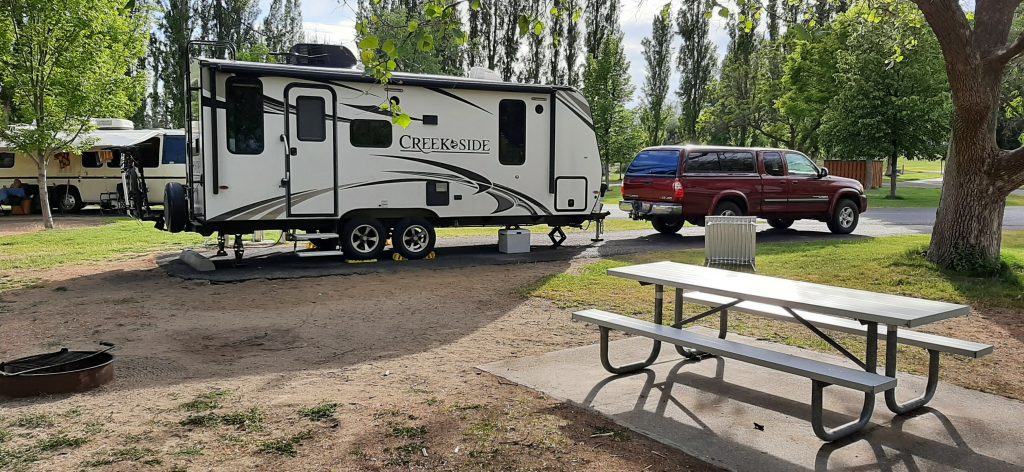
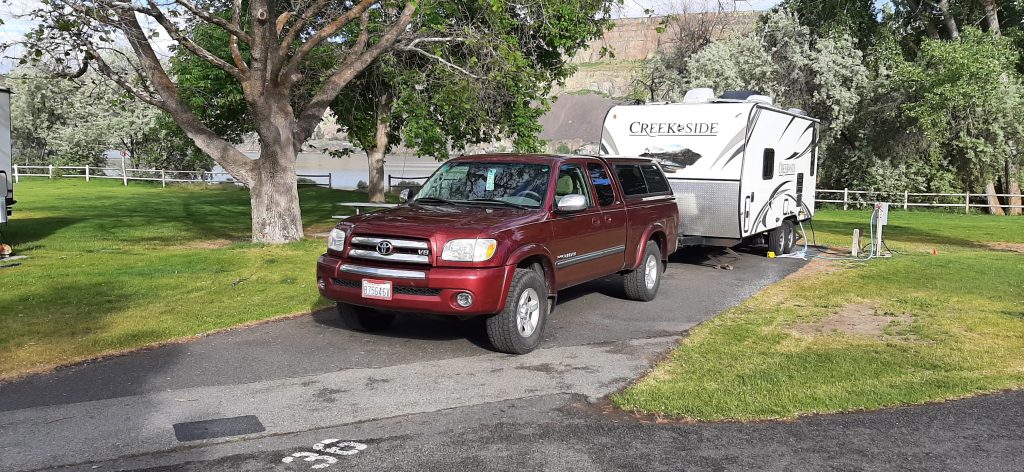
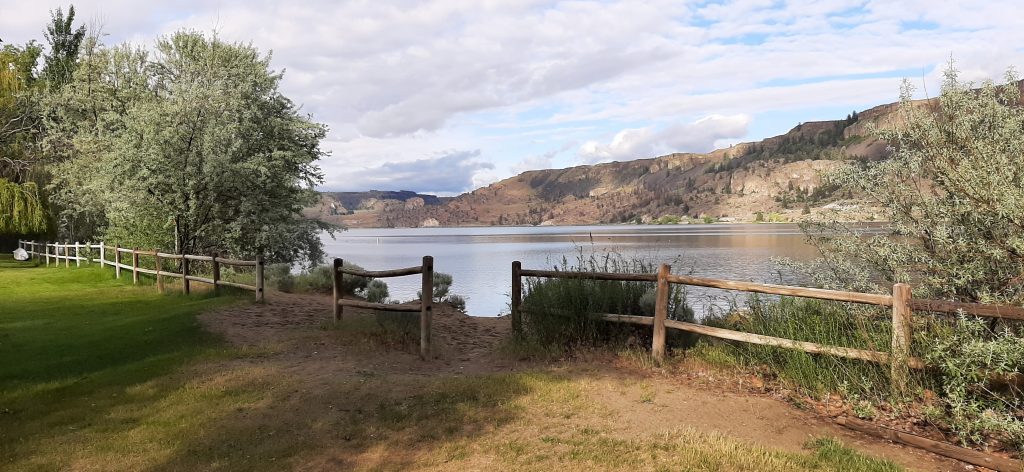
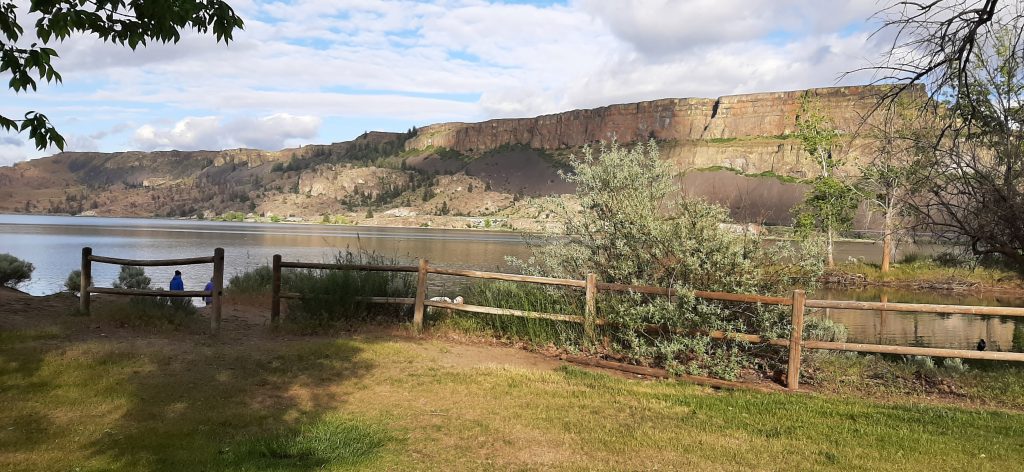
Woke up in the middle of the night to raindrops falling on my head. Not really. But raindrops performing a patter song on our trailer. Not what you want to hear, especially when it’s a day to hitch up and head to your next campground. But by about 10:00 am the rain had stopped. So, we managed to escape camp without having to change out of wet clothes. Always a good sign.
Then back down SH-153 along the Methow River to Pateros. Then left (north) on to US-97 (straight would have dumped us in the Columbia River) to Brewster. At Brewster we left 97, crossed the Columbia River and were now on SH-173. At Bridgeport we once again changed state highways. We were then on SH-17 which goes up and up over barren hills until we reached Leah and turned on to SH-174. Which continued our up, up, up and away until it was down, down, down to Coulee Dam. At which point we turned south, southwest on SH-155 through Electric City and to our final destination – Steamboat Rock State Park.
After getting set up we had a small lunch.
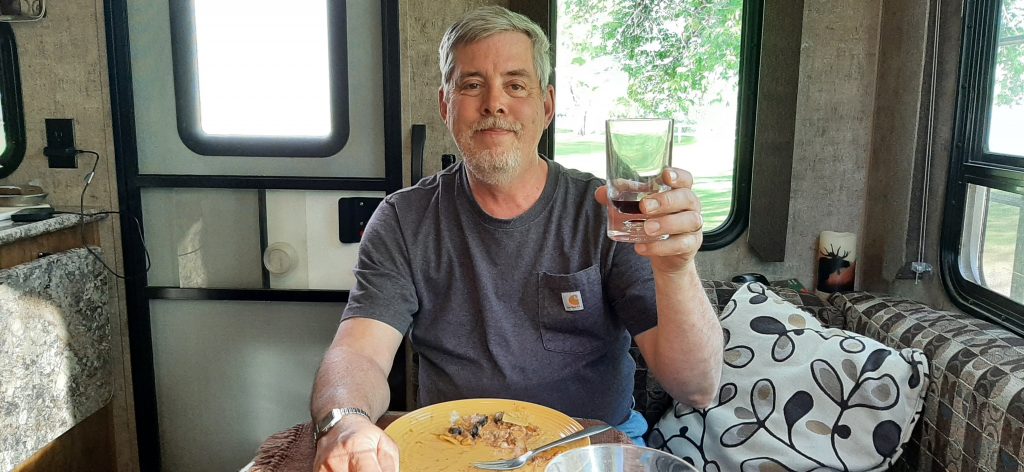
Who cares if it’s sunny or warm. I’ve got my love to keep me warm. That and a nice lunch and perhaps a safe arrival beer.
While happily sitting in our trailer it started to rain. So, we had just missed the rainstorm both hitching up and unhitching. Some days are just better than others. And we were safe and sound in a park we love, with our back window facing the lake. Banks Lake to be precise.
Banks Lake, part of the Columbia Basin Project, was created by building two rock-faced, earth filled dams at the north and south ends of the Ice-Age channel of the Columbia River, now known as Grand Coulee. The reservoir is 27 miles long with 27,000 water surface acres. Water is pumped for irrigation from Lake Roosevelt by 12 huge pumps up 280 feet into the lake.
We had previously stayed at this lovely park in 2016 and had been eager to return. It truly is beautiful in the Grand Coulee area.
But after a long day of driving, we were happy to stay in our trailer, me writing, and Andy plotting a short hike for himself the next day. At that particular moment (I call it a 15-minute lucky streak), all was all right with the world.
MAY 23, 2024 – STEAMBOAT ROCK STATE PARK
Woke to the promise of rain, wind, thunder clouds, and clear skies – a complete change every 15 minutes. So, after breakfast we decided a ride was in order. So, with our trusty Washington Road & Recreation Atlas in hand, off we went.
Our first adventure was to go north a short way along Banks Lake to the Northrop Point Day use area. A huge boat launching and picnic area. Then up Northrop Canyon to where Andy would take a 3-mile round trip hike later in the afternoon.
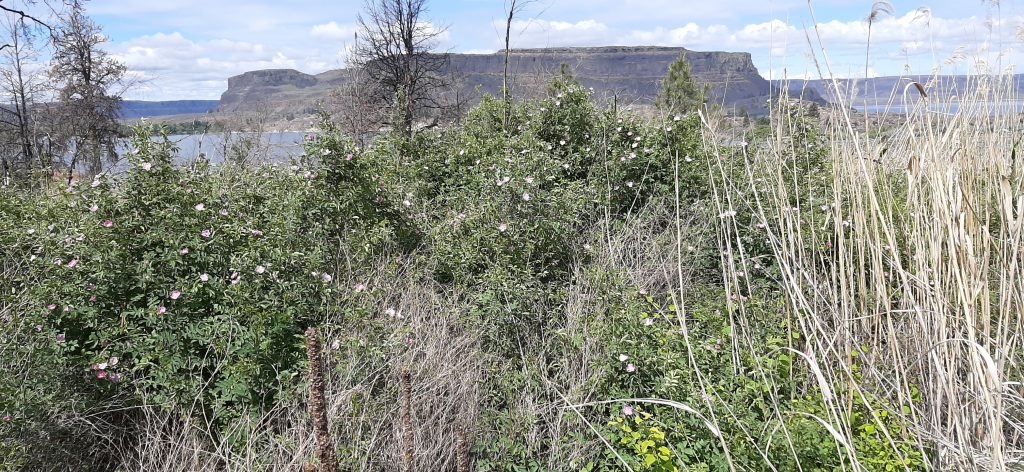
Steamboat Rock from our drive
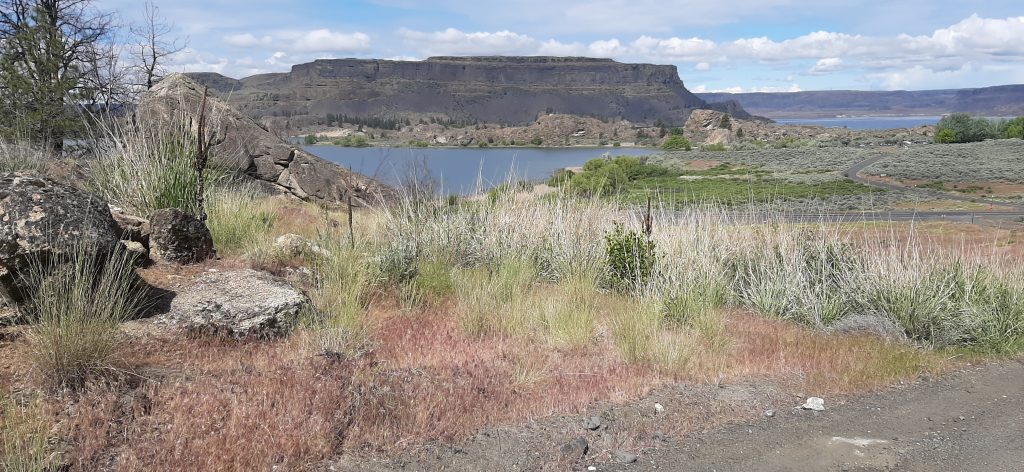
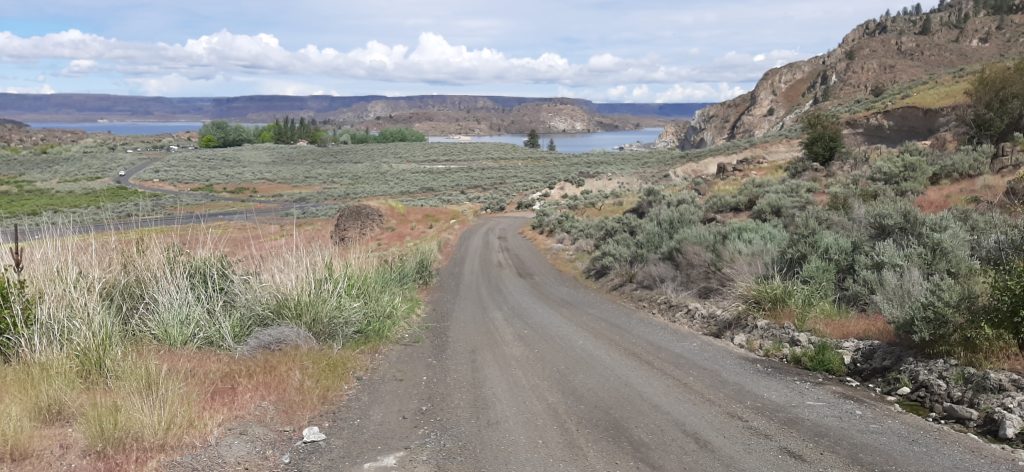
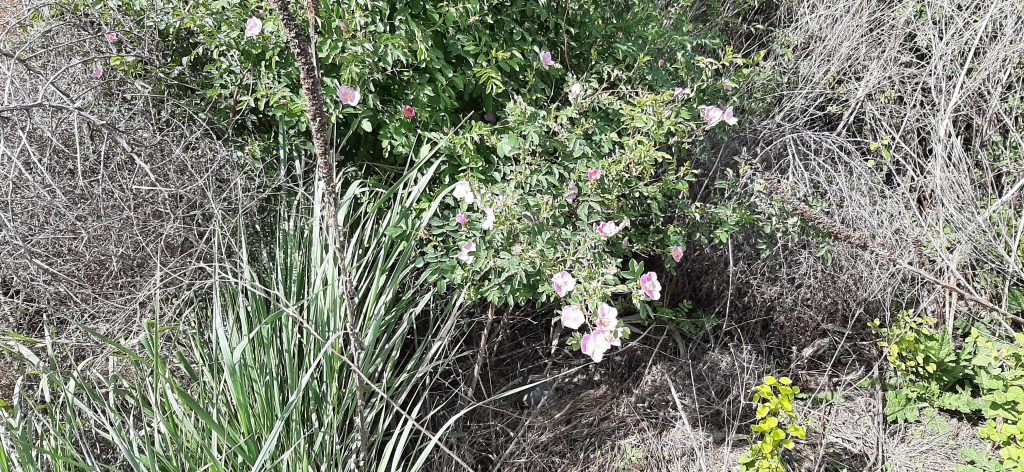
Beautiful foliage along the drive. (Wild roses I’m guessing.)
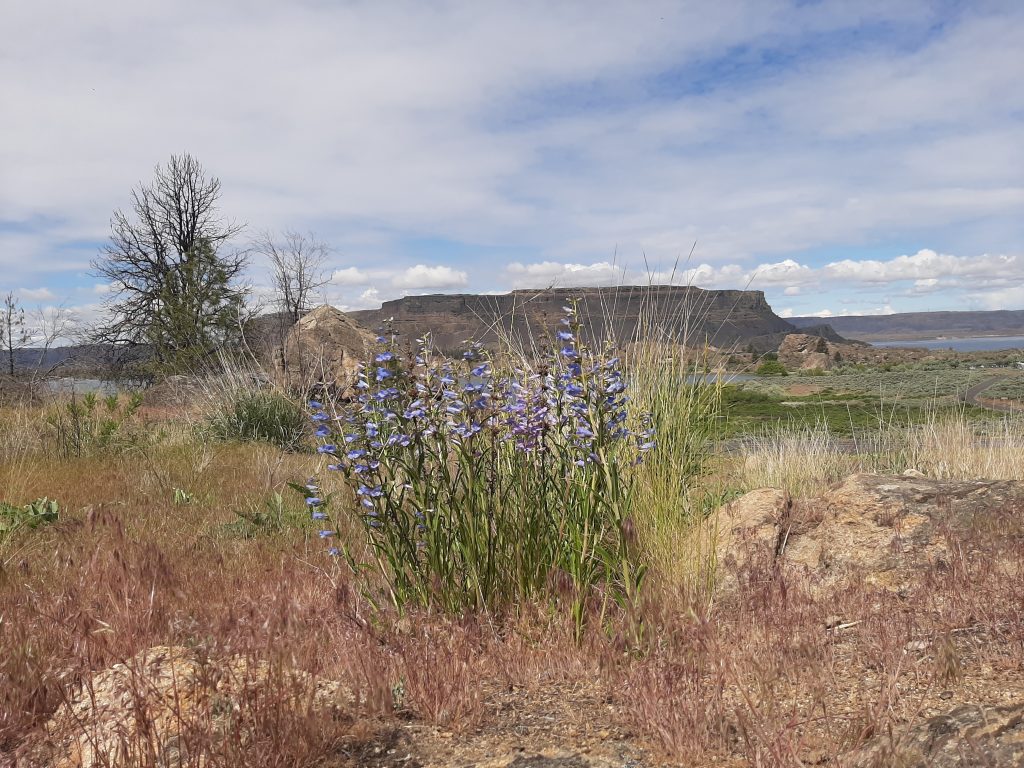
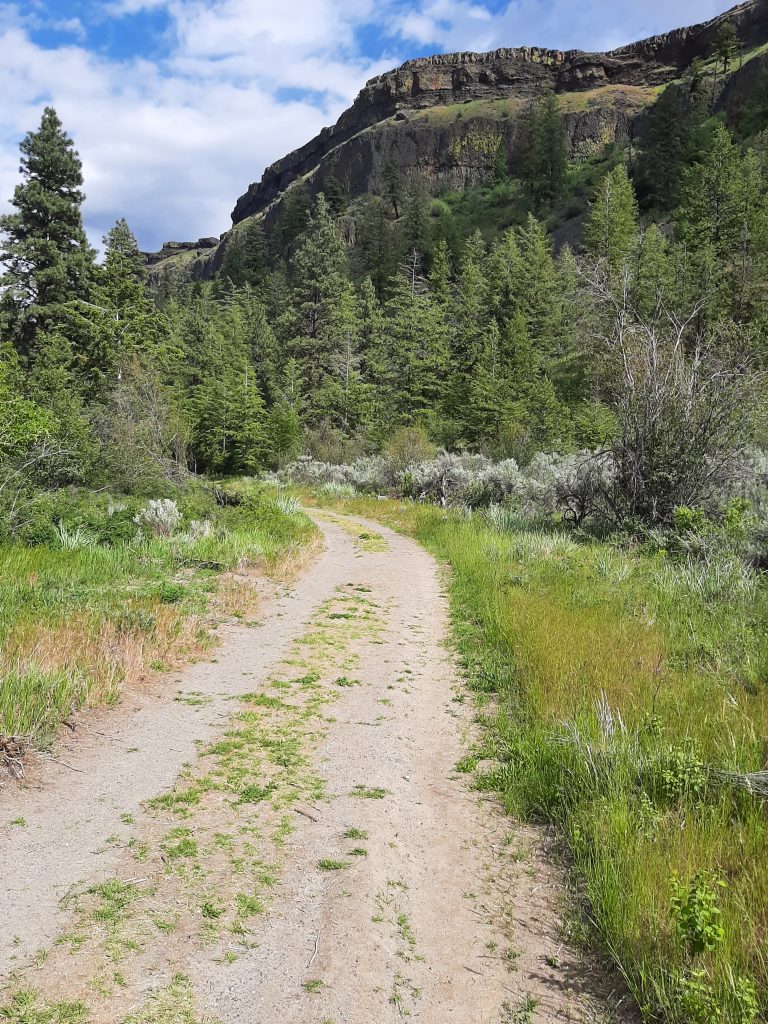
Next, we drove south along the shore of Banks Lake to the very end and followed US-2 west to Jamison Lake Road which took us north through Moses Coulee to (you guessed it) Jamison Lake. And what a beautiful lake we found.
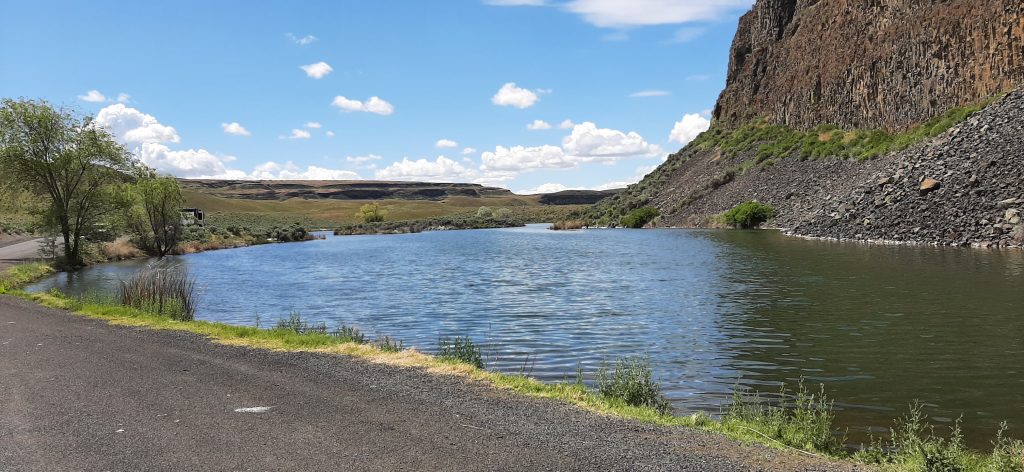
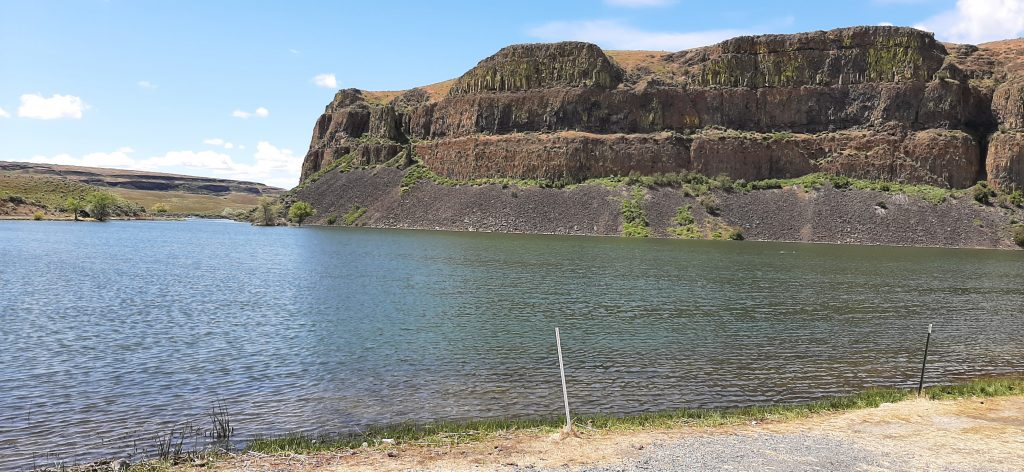
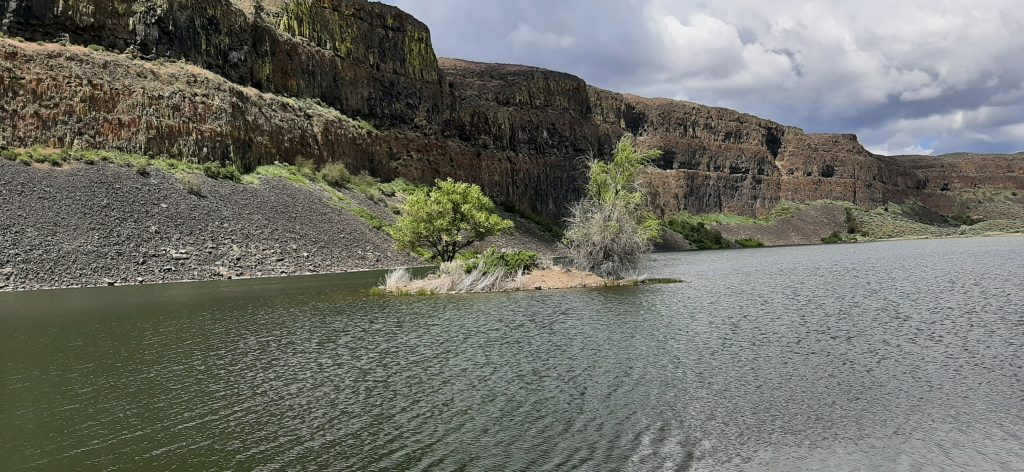
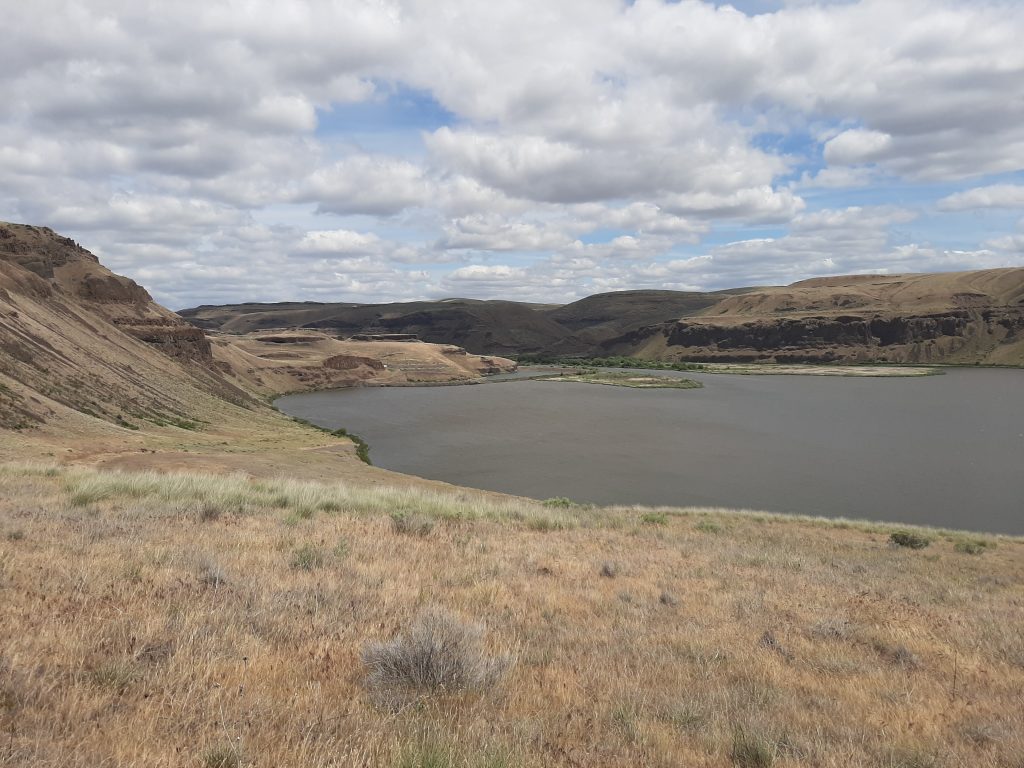
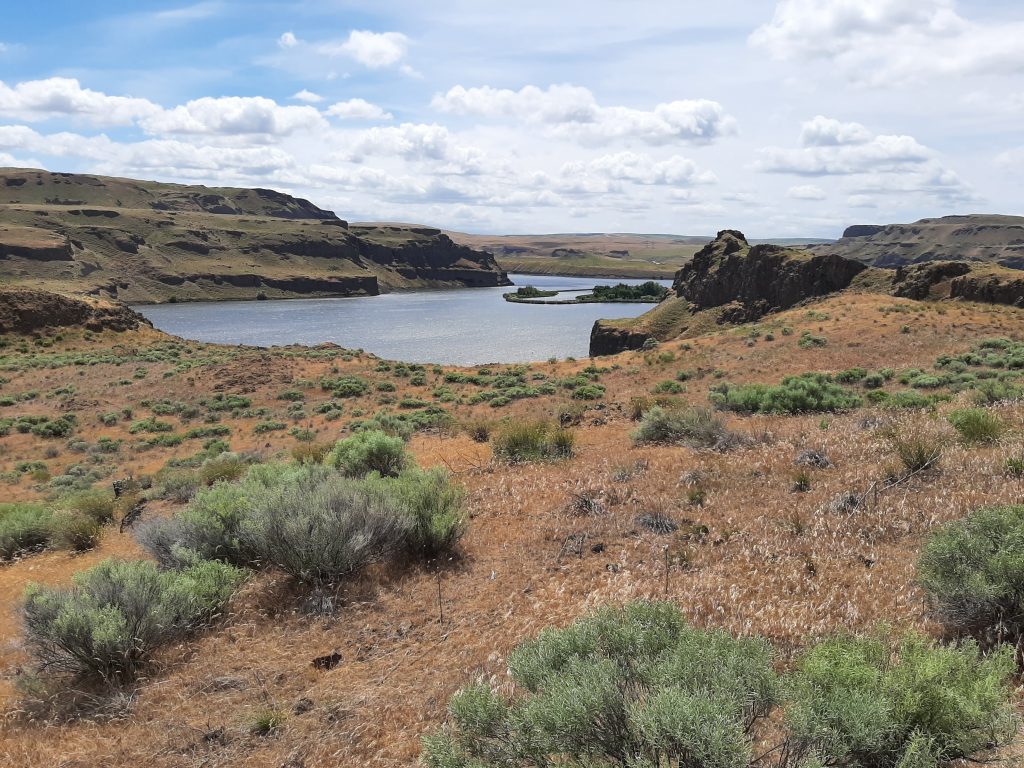
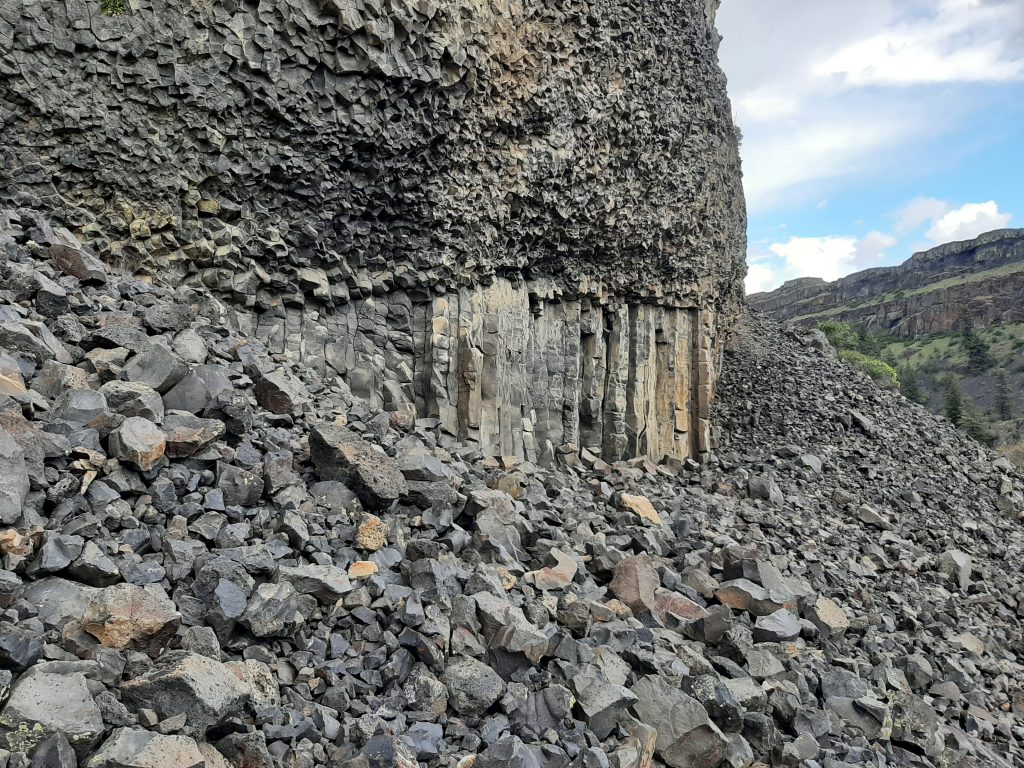
Up close look at the basalt formation
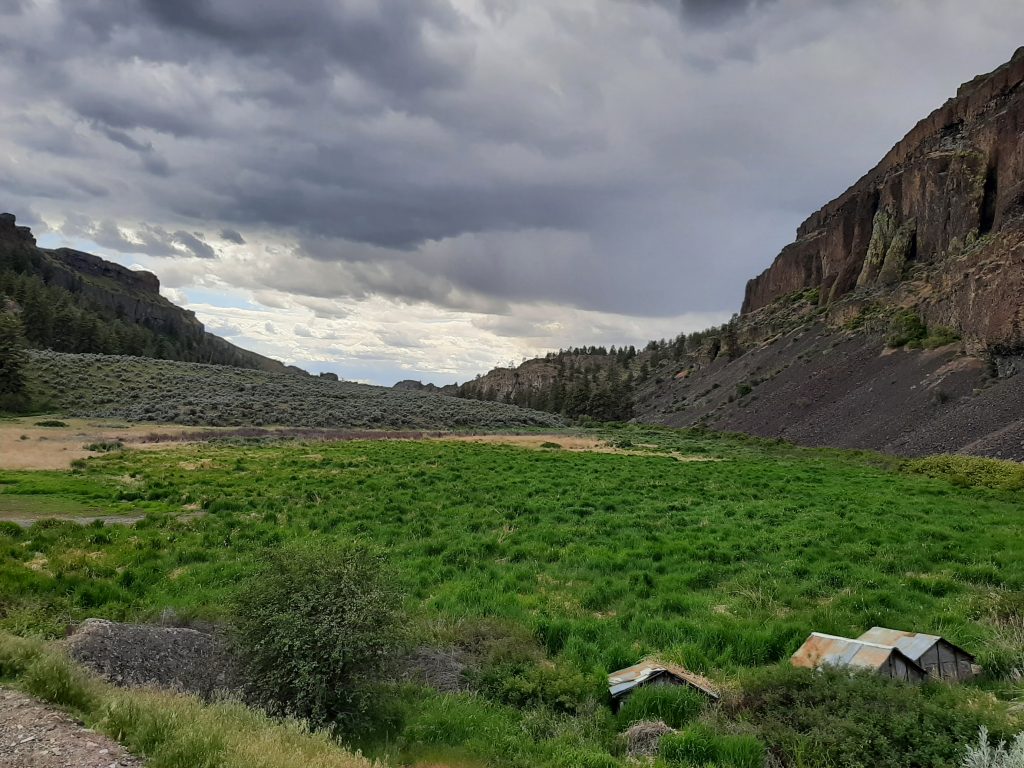
This photo shows the basalt sides of Moses Coulee. Amazing.
The lake was charming. Complete with a blue heron and various species of ducks including loons. And of course, throughout the entire drive up and back from the lake we were able to enjoy a close-up view of the majestic rock walls of this coulee. Most of the vertical walls consisting of basalt columns. And as everyone knows, basalt, which composes about 90% of all volcanic rock on earth, is an aphanitic extrusive igneous rock formed from the rapid cooling of low-viscosity lava rich in magnesium and iron exposed at or very near a planet’s surface.
After spending a bit of time enjoying the natural wonders this area had to offer, we headed back through Coulee City and up to Billy Clapp Lake. Our map indicated that there was a waterfall, but we sure couldn’t find one. But the ride was nice.
It’s interesting to be driving along and suddenly you are on one of the many bridges over the large canal (water released from Banks Lake) that supplies much of the irrigation water for the area around Ephrata and the upper Columbia Basin. Basically, the massive fields of grain, etc. north of Moses Lake. I would have expected the water to be murky. But it’s not. It’s crystal clear and blue.
Then we gassed up in Coulee City and drove back to camp for a small lunch before Andy took off for his afternoon hike. I stayed in camp and read outside until I was driven inside the trailer by a short rainstorm.
After Andy arrived back at the trailer a little after 5:00 pm, we headed over to Dave and Jeri’s trailer for dinner. Along with their dear friends Doug and Ramona, we had a fantastic meal. Chicken cordon blue lasagna, romaine salad with dried cranberries and glazed pecans, warm crusty bread, and strawberry tiramisu for dessert. All of which Jeri prepared in their trailer. And yes, I was more than impressed. I have never made anything that elaborate in our trailer. But it certainly was a call for me to up my game!
This was our second dinner with these lovely people. And had been planned before we left home. But because of our previous truck problems at Summerhill Farm, we had been fortunate enough to have not just one but two wonderful dinners and evenings in their presence.
Then back to our trailer for Andy to take a shower, me to do some writing, and the heavens to open. Nothing like a hard rain to settle the dust. And from the sound of things, there won’t be any dust around for quite some time.
Then to bed to dream of traveling to our next destination after yet another fun day in Eastern Washington.
MAY 24, 2024 – TUCANNON RIVER RV PARK – site 18
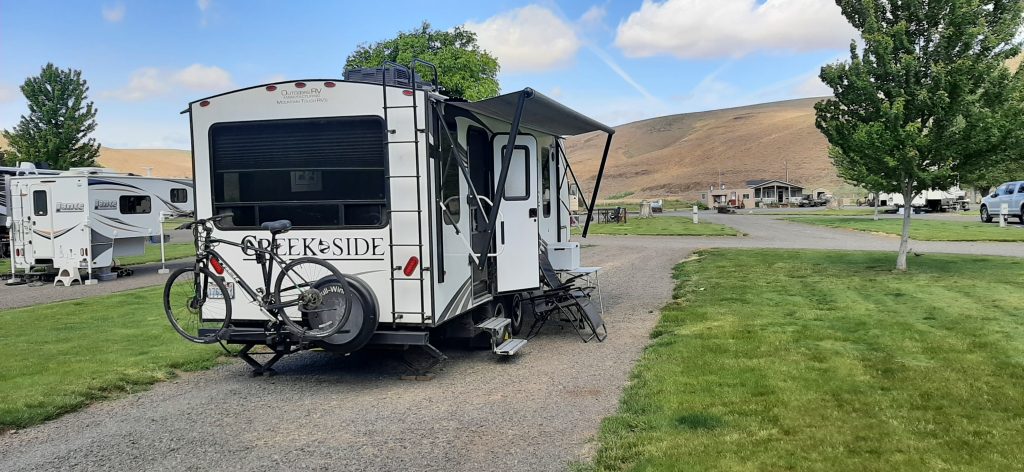
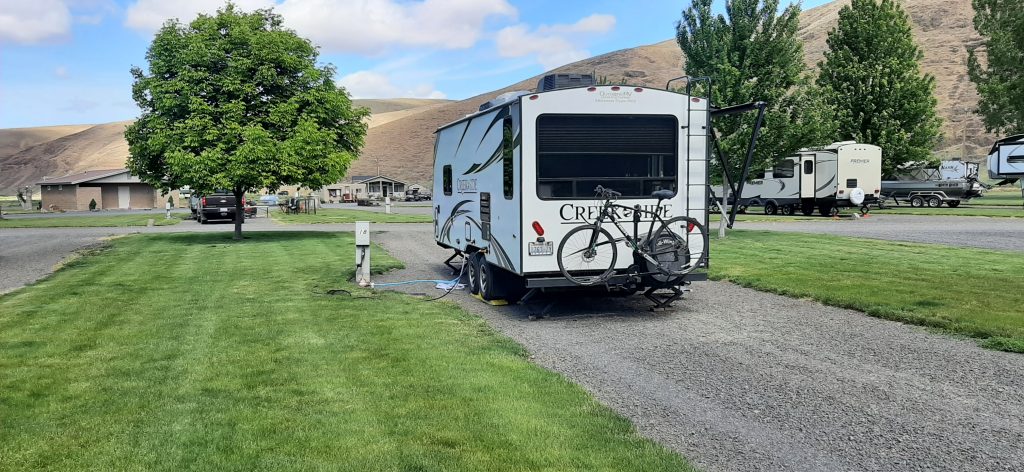
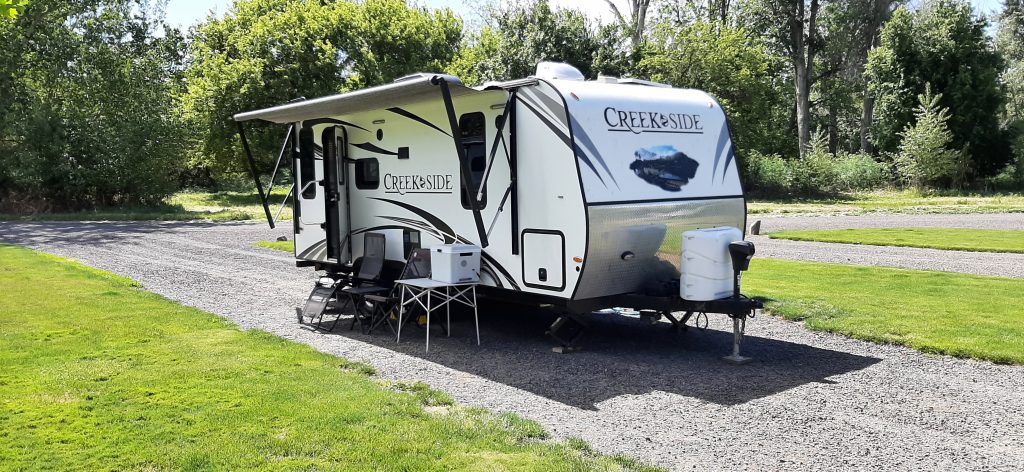
Well, once again it was time to hitch up Pullwinkle. The name of our trailer because we (and I use the term “we” loosely) have a whole “moose” theme going on in our 24-foot, 7-inch home away from home. But there was yet another wonderful RV park to visit on this trip.
We would have loved to stay longer at Steamboat Rock SP, but even though I booked our sites on January 7th, there weren’t any available for the Memorial Day weekend. In fact, we were lucky to reserve the Tuesday, Wednesday, and Thursday nights just prior to Memorial Day. Or as I refer to Memorial Day – “Campground Madness Day”. And then even luckier to be right on Banks Lake.
FYI – booking campsites has literally become a competitive sport! I’m just surprised it has yet to qualify as an Olympic sport because there are definitely winners and losers! And you must prepare for an upcoming “event” months in advance. (I rest my case!)
So, what did we learn on our drive from Coulee City to around the time we hit the Lyons Ferry bridge? Well, having never been on most of our route today, we were amazed by all the farmland. Mile after mile after mile of wheat and what we believe to be canola plants. More land devoted to crops than we ever imagined. (BTW, just driving along I-90 does not give you the same scenery or perspective on how this land is being utilized. I-90 provides you mainly with acre after acre of sagebrush!)
According to spokesman.com “Travelers driving through the rolling hills of the Palouse this summer may have noticed more fields that glow bright yellow. The yellow blossoms belong to the canola plant, which has become a hot commodity for Eastern Washington farmers.
Canola production and planting acreage in Washington has increased steadily over the last 10 years, according to data from the U.S. Department of Agriculture. In 2011, around 11,000 acres were planted with canola, compared to more than 118,000 acres planted in 2021. In Whitman County alone, canola acreage doubled year-to-year in 2021.”
And where we used to think of this plant as simply rapeseed, it has become confusing. Rapeseed and canola oil are still from the same species. Rapeseed is the traditional name for the group of oilseed crops in the Brassicaceae family. However, that group is now divided into two products. Although derived from the same plant, rapeseed is used for industrial purposes. While canola is a genetically modified version used in cooking. And bottom line – canola oil along with olive oil and safflower oils are healthier choices overall than butter. (Since this report is being posted on a cooking blog, I felt compelled to make some kind of cooking reference.)
Along with all the planted fields, we also witnessed many, many fallow fields. Which made me wonder if we were still paying farmers not to plant crops.
According to Robert Frank, guest blogger for PBS when asked – Why does the government pay farmers not to grow crops?
“Paying farmers not to grow crops was a substitute for agricultural price support programs designed to ensure that farmers could always sell their crops for enough to support themselves. The price support program meant that farmers had to incur the expense of plowing their fields, fertilizing, irrigating, spraying, and harvesting them, and then selling their crops to the government, which stored them in silos until they either rotted or were consumed by rodents. It was much cheaper just to pay farmers not to grow the crops in the first place.
Of course, paying people not to do work is bound to be politically awkward (think of the old New Yorker cartoon of an accordion player on a subway platform with a sign next to his cup that read, “Will not play Lady of Spain, 25 cents”). So, the government described the program as an environmental one rather than an income maintenance scheme. As described to the public, it was compensation to farmers for retiring acreage to reduce fertilizer and pesticide runoff into the nation’s water supply.”
Washington Farm Subsidy Breakdown, 1995-2023
Commodity programs – $3.64 billion
Crop Insurance Subsidies – $1.78 billion
Disaster Programs – $718 million
Conservation Programs – $2.15 billion
Seems pretty high, but according to Pam Lewison, Director, Center for Agriculture in an article on washingtonpolicy.org “There are 14,700,000 acres farmed in Washington state. The U.S. Department of Agriculture 2017 Census of Agriculture shows there are 6.4 million acres of irrigated farmland and an additional 10,000 acres dedicated to other irrigated agricultural land uses. The counties included in the ECONorthwest study – Adams, Asotin, Benton, Columbia, Franklin, Garfield, Walla Walla, Whitman – account for 4,975,510 acres, or 33 percent, of the total farmland in our state.
Whitman County boasts the largest amount of farmland acres in the study with 1.2 million and has developed into the breadbasket of our state while remaining a largely dryland farming area. Whitman County leads the state in grain production with approximately $259 million in sales recorded in the 2017 Census of Agriculture.
Benton County has half as many acres devoted to farmland, with 613,000, but leads the state in production of some of Washington’s most irrigation-dependent crops – vegetables, melons, potatoes, and sweet potatoes and generated just over $1 billion in sales in 2017. Despite having half the acreage, the bounty of Benton County is more valuable than that of Whitman County, simply because it has more irrigated land.
Irrigation water in agriculture is extremely valuable. As demonstrated by the difference in revenue between Whitman and Benton counties, the assertion by this study that “dryland farming is economically feasible in the region” does not mean that it is the most effective means for all farmers in the region to operate their businesses.
Additionally, the study cites 198,227 acres of “non-irrigated cereal grains cultivated within a five-mile radius of the Lower Snake River Dams area. The ubiquitous nature of the number of acres of non-irrigated cereal grains in the region does not necessarily indicate a positive economic correlation to dry land farming. Referring back to the difference between Whitman and Benton counties, Whitman County, where non-irrigated cereal grains drive the agricultural economy, the average size of a farm is approximately 1,200 acres. In comparison, in Benton County, where heavily irrigated crops provide nearly five times as much income, farms are approximately 400 acres in size.”
But enough about the economics of farming in this part of the world. Just suffice it to say there is a lot of land being cultivated. And there isn’t enough money in the world to get me to live such an isolated existence. I’d be climbing the farmhouse walls within 2 days!
And since I probably will never come to this campground on the same roads we traveled today, even though I saw more flour and canola oil on the hoof (so to speak) than I could ever have imagined, it was interesting. Once!
After leaving Steamboat Rock SP, we turned right onto SH-155 to Coulee City. Then we headed east on US-2 towards the huge burg of Wilbur where we turned south onto SH-21 towards Odessa. (Hopefully the “Odessa” in the Ukraine is more interesting than Odessa, Washington. Just saying!) Anyway, then left onto Rosenoff Road and into the thriving town of Ritzville where we stopped for lunch.
From there it was under I-90 and south to Washtucna on SH-261. (We do find the most interesting places on our travels! Washtucna however, not being one of them.) Then SH-260 for a brief spell, and back on SH-261 to cross the Snake River at the Lyons Ferry Bridge and past the bustling dot on the map (Starbuck} and our final destination – Tucannon River RV Resort. Which BTW is worth the ride!
Then settle in, enjoy happy hour, and an early to bed for me.
MAY 25, 2024 – TUCANNON RIVER RV PARK
Once again it was windy, cloudy, sunny, you name it, we had it. Except for snow or rain, which of course was very nice.
After breakfast Andy headed out for a short hike to Marmes Pond. Not a hard hike, but enjoyable just being outside.
While Andy hiked, I wrote up yesterday’s adventures. When he returned, we decided to go for a drive. So, we turned left out of our campground and proceeded to Starbuck. Not Starbucks, because there was no coffee involved with this visit. We were simply driving through town (and I use the term “town” exceedingly loosely), looking for the Kellog Hollow Road. And of course there were no road signs. But how many roads can there be out of a town of 121 people (as of 2022)! So, with Mr. Cs innate ability to find his way through a dark cave blindfolded, we found the right road. And when I say the “right” road, I truly mean it.
This was one of the most beautiful drives I have ever taken. A narrow hollow through beautiful, cultivated fields and at the “top” of the road, a view into the snowy Blue Mountains. Gorgeous vistas. At a T in the road, we turned right onto Mackay-Alto, then onto Cannery Road for a mile or so into the charming small town of Waitsburg. Pretty older homes, well taken care of, with mature trees providing lots of shade, I’m sure absolutely treasured during the long, hot summer months.
Then back onto US-12 to Dayton where we shopped for groceries. Although Waitsburg and Dayton are not that far apart geographically, they are worlds apart when it comes to charm and pleasant amenities. Dayton is dry and pedestrian, whereas Waitsburg looks like a small college town. Filled with people who obviously take pride in their own homes and in their well-kept city.
Then back to camp to enjoy the late afternoon reading in our comfy outdoor chairs.
At about 5:30 pm I started dinner since we had not had any lunch.
After dinner it was reading for both of us until we could no longer keep our eyes open.
But what a wonderful day. If you are ever in this area and camped at Tucannon River RV Park, I recommend you drive the loop described above.
In May, when the wheat is only about a foot tall and the most beautiful green you’ve ever seen, the loop drive is amazing. In September, when the hills are dry, maybe not so much. But regardless, this is a unique and interesting part of our beautiful state. And we are thoroughly enjoying our time here.
MAY 26, 2024 – TUCANNON RIVER RV PARK
When is it not wonderful to wake up to clear skies? Well, perhaps in August, but definitely not today May 26th. Because the temperature is perfect, and we have a great plan for today. But first, a hearty breakfast. So, after a link sausage, sharp cheddar cheese, and 4 farm-fresh eggs scramble, a toasted half English muffin each, a half grapefruit each, and lime-flavored yogurt, we were ready for an adventure.
First, we headed up to Palouse Falls. We had been there last April, but we were a little later this spring and thought there might be more water careening down the face of a cliff. And we were right. The falls were magnificent.
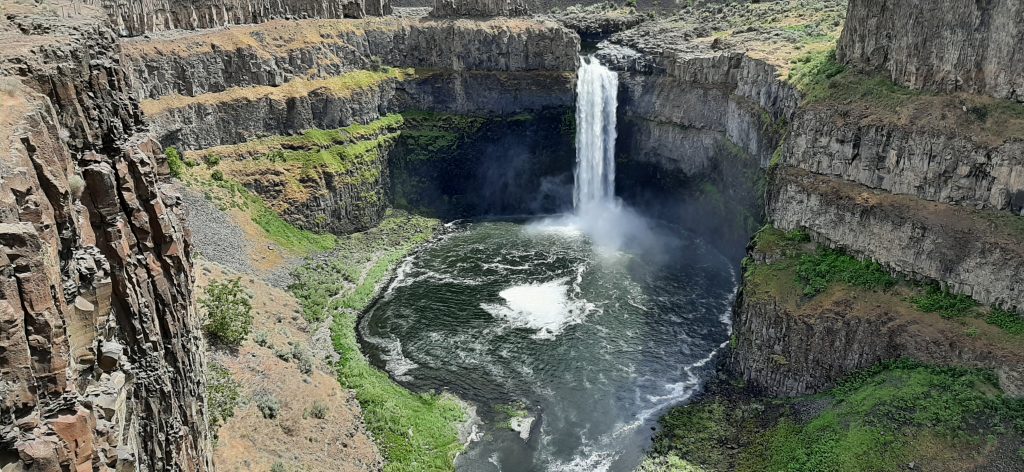
As we were driving away from the park, Andy asked me if I would enjoy a longer ride because he had a suggestion if I was game. And of course, I am always up for a bit of an escapade. And what an exciting adventure it turned out to be. We decided to go check out the Lower Granite Lock and Dam. Never been there? Well, you will want to visit it after I tell you about what a great experience we had.
Between 1955 and 1975, the US Army Corp of Engineers built 4 dams along the lower Snake River. One of the dams being the Lower Granite Lock and Dam which is set in an area of towering walls of basalt columns and majestic views.
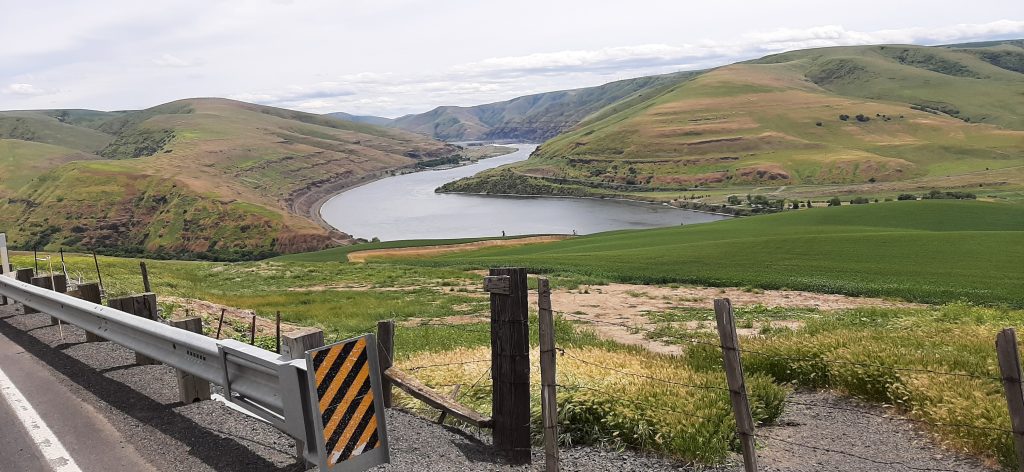
The drive down to the river and dam
The facility includes a dam, a navigation lock, powerhouse, a fish ladder, and associated facilities such as a visitor’s center. It provides hydropower, navigation, flood risk management, fish and wildlife habitat, recreation, and incidental irrigation. The dam is about 3,200 feet long with an effective height of 100 feet. And the really cool part is that you can drive over this concrete behemoth.
Of course, first you have to check in with a guard who writes down your vehicle license plate number and your driver’s license number. Then off you go making your way across this massive concrete structure which includes several tight turns. All the while every bit of the journey is just begging to be photographed. But there are very strict rules about stopping on the dam. Number 1 being – don’t stop. And unsaid but perfectly understood by anyone with half a brain – don’t jump! But as Andy slowly drove across this amazing man-made structure, I was able to snap a few pictures from the passenger side open window. As you approach the other side of the dam, there is another guard station and a gate to be raised if you have dutifully made no errors in judgement as you make the crossing. We apparently hadn’t been bad because they let us go through.
The following are pictures taken along our crossing
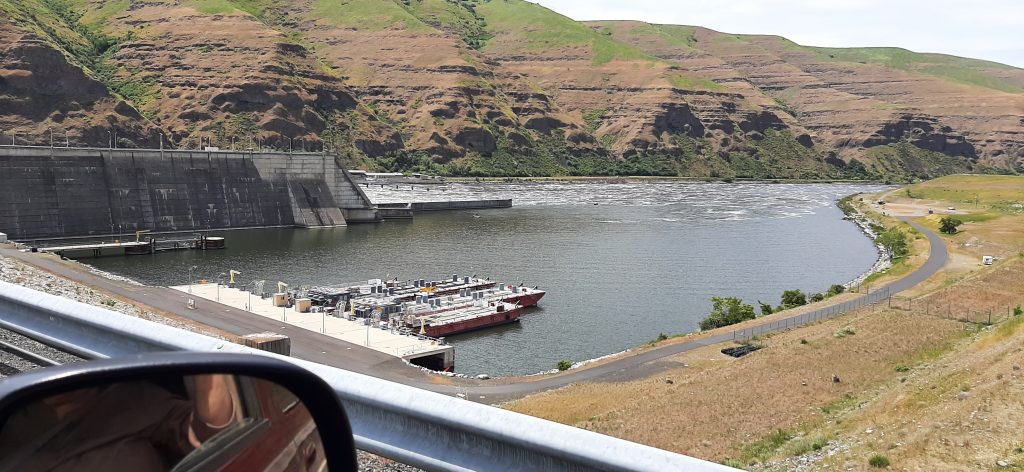
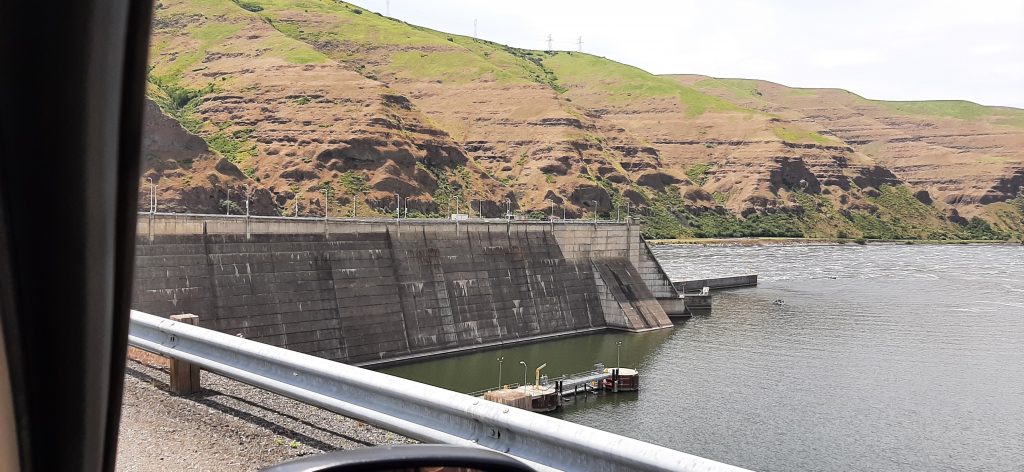
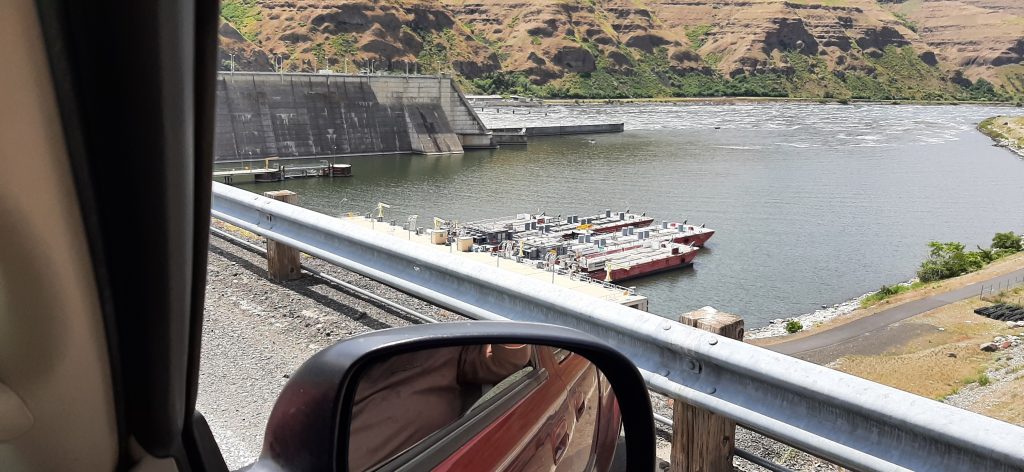
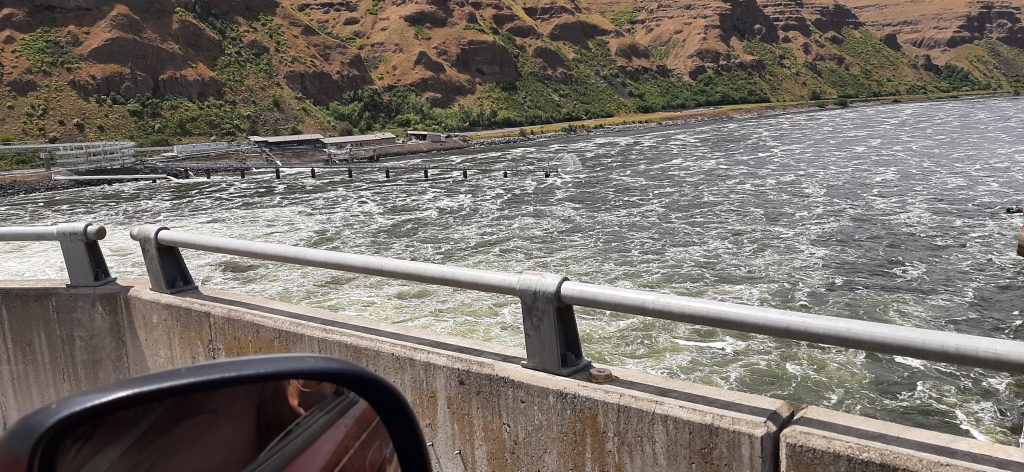
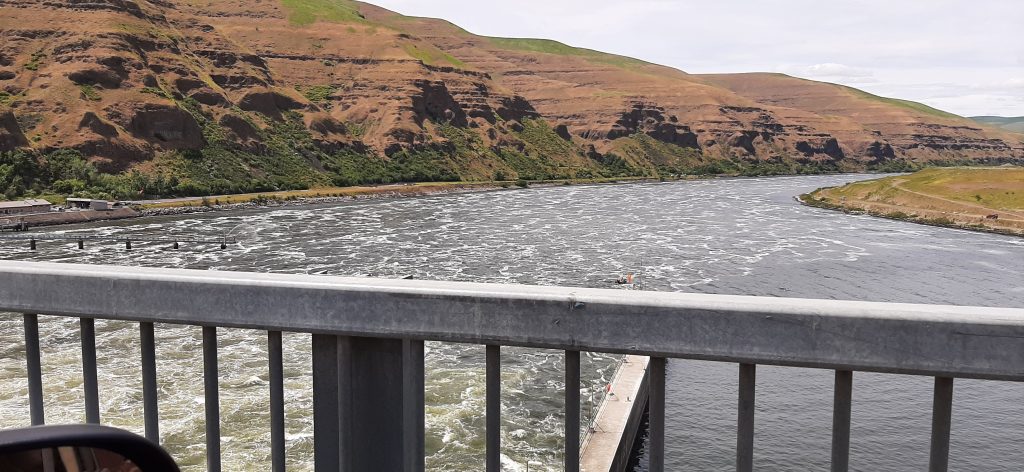
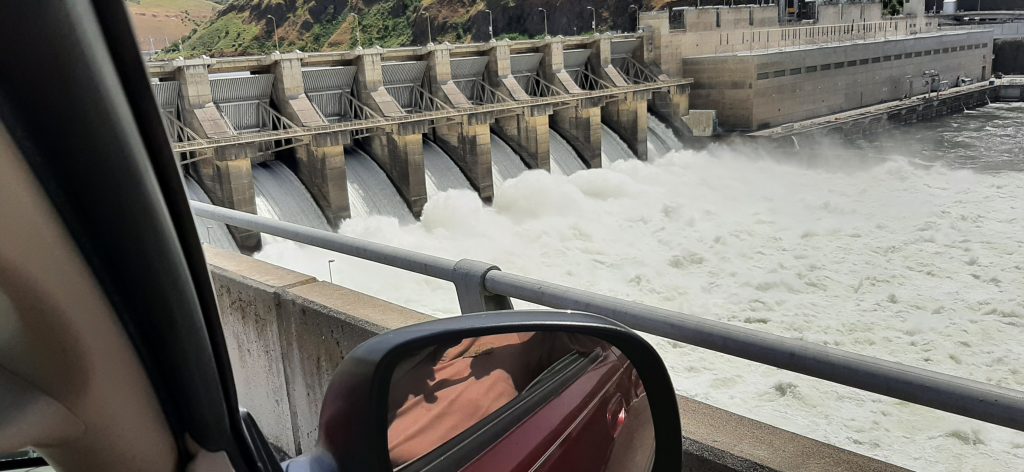
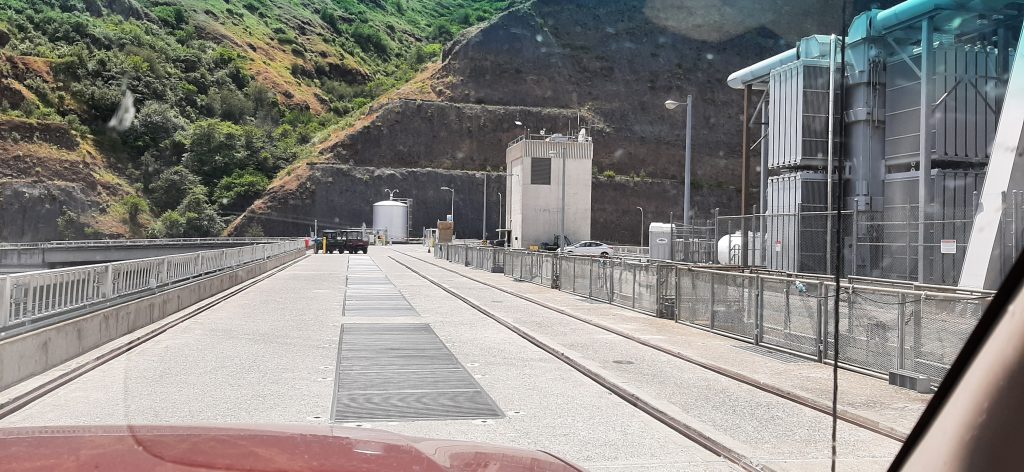
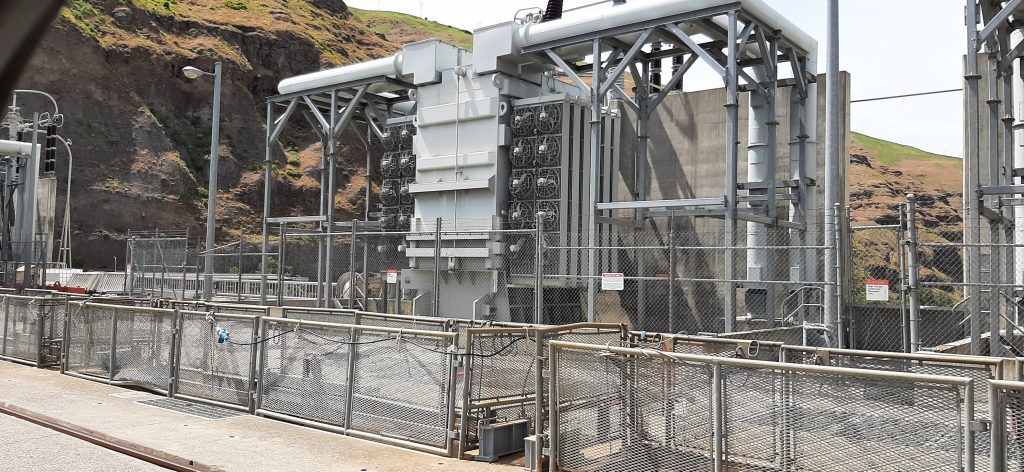
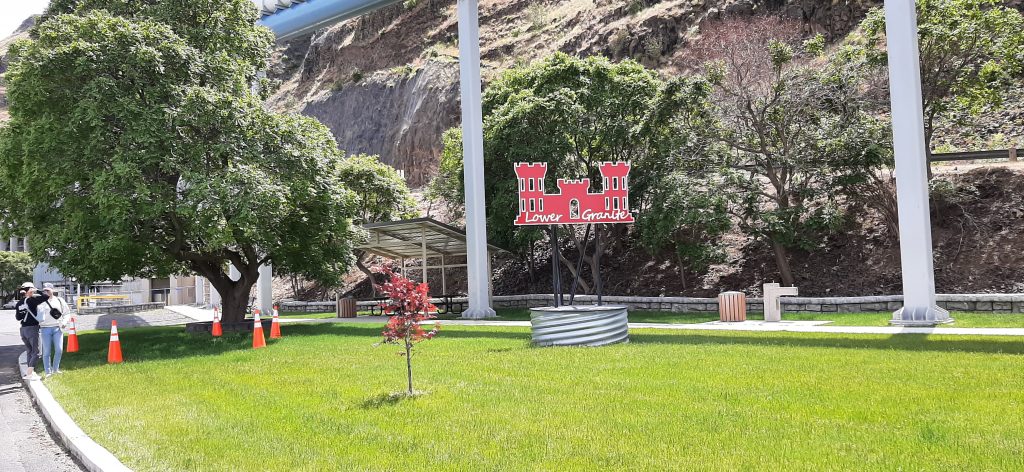
Our approach to the visitor’s center
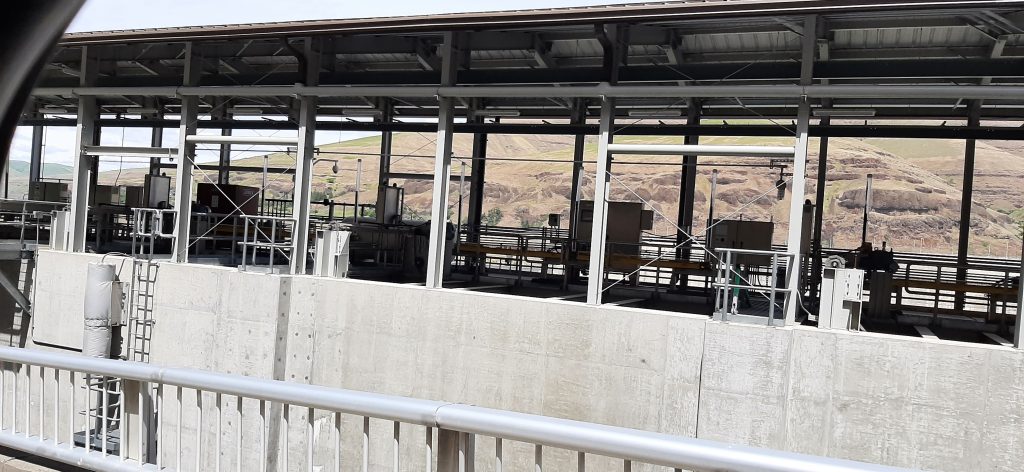
Fish ladder system near the visitor’s center
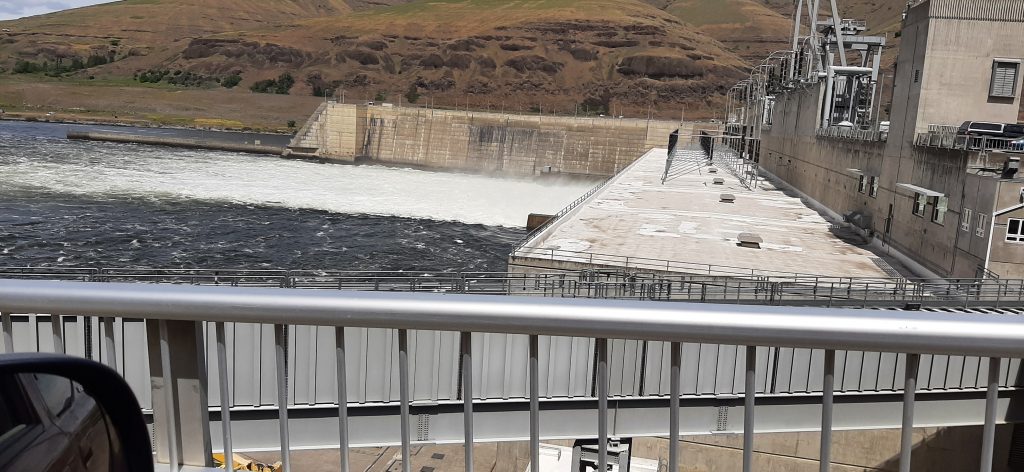
View back across the dam
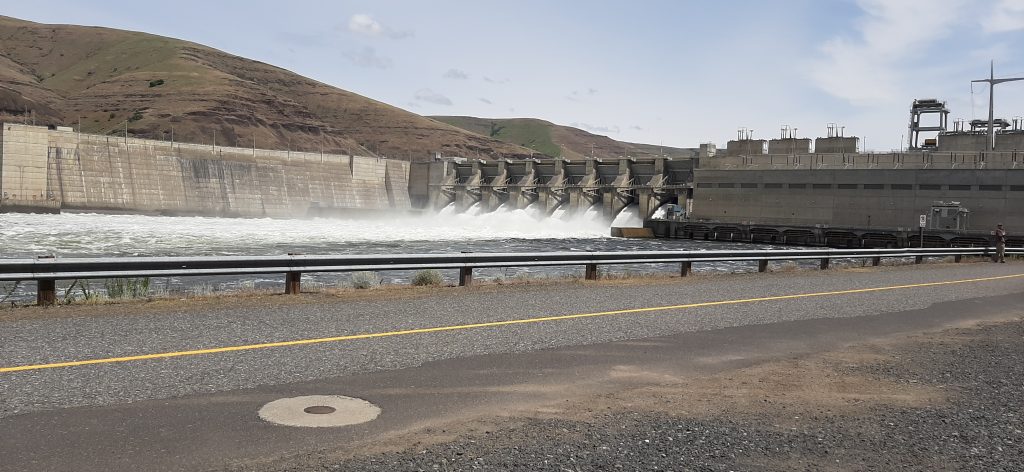
Another view back at the dam
Next, we stopped at the visitor center. Nice facility with bathrooms, a short film about the dam, and picnic tables right next to the churning water. All and all, a great place to visit.
But before you even reach the dam, the last part of the drive down to the river is worth the whole trip. So, before I go any further, I will record the route we took to get to the dam. It was part of another loop trip and made for a lovely way to see the surrounding countryside.
After leaving Palouse Falls, we turned right onto SH-261. Then 260 to Washtucna. Then 40 miles on SH-26 to Summers Road then turned right on Almota/SH-194 down to the water. Then left along the water until we got to the dam gate.
After crossing the dam and a quick stop at the visitor’s center, we proceeded along the river shore until it was up through more cultivated hills and away from the river.
Something you should know. There is not a straight road to be had in this part of the country. OK, maybe if you are on I-90. But the rest of the roads are up down curvy and fairly narrow. At least the ones we drove, that is! And paved. We were advised by the gate keeper at the dam to stay on the paved roads. So, that’s just what we did.
But he was not always able to provide us with the name or number of the roads he suggested we take. More on the “turn right at the intersection after the white house” kind of instructions. Turned out to be Gould City – Mayfair Road. Then a sweeping right turn (his description) onto (as it turned out) Dead Man Road (along Dead Man Creek) and down to SR-127 (the road that eventually goes over Central Ferry Bridge which we did not cross). Instead, we turned left and to US-12 which brought us back to camp.
At camp we rested for about an hour and then headed to and through Dayton to visit the Dumas Station Winery where Mr. C. thought the wine was great and therefore purchased 6 bottles. Then back into Dayton for pizza at the Chief Springs Pub.
Then back to camp for a bit of reading before our pillows kept yelling at us to “come to bed”. And as everyone knows, when pillows beckon, it’s futile to not pay attention. Pillows after all know what’s best for us! And we have learned after years of fighting their siren call, that even if we ignore them, they will win in the end.
Another fun day in Eastern Washington. But I swear, I am never going back to Washtucna!
MAY 27, 2024 – DAROGA STATE PARK, ORANDO – site 9
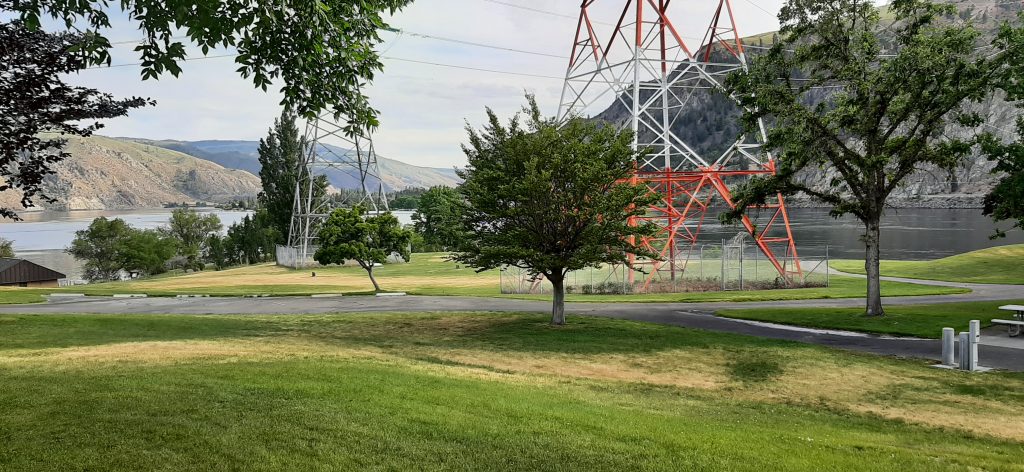
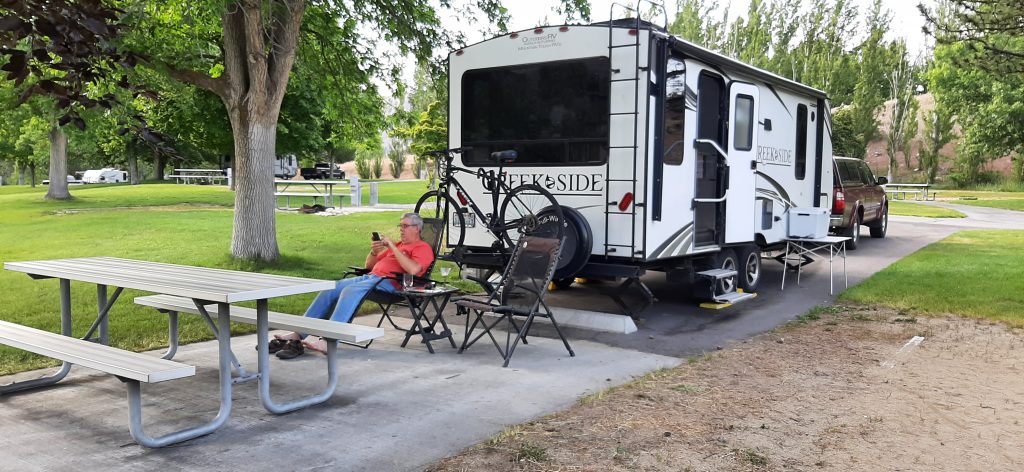
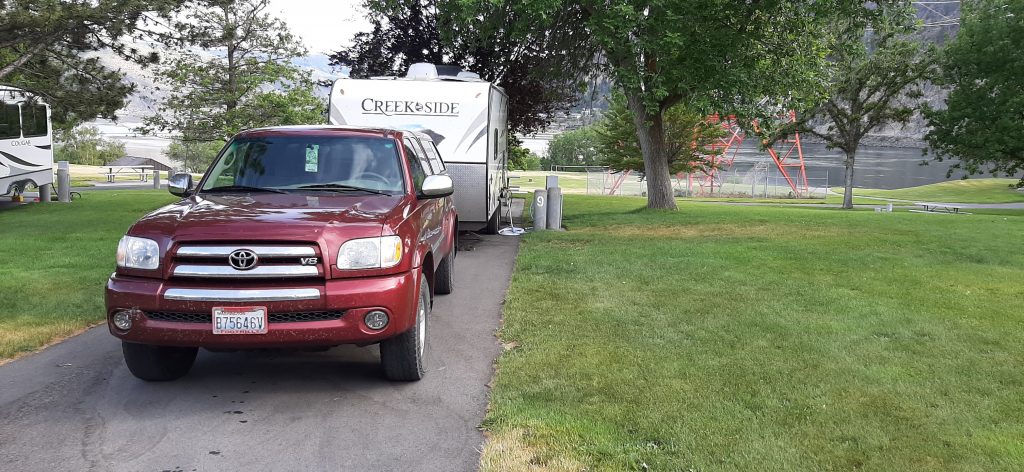
Once again it was time to move to a new location. Sometimes I am eager to get going. Other times like today, I’m sorry to say goodbye to an RV park that has become an old friend. And that’s how I felt today. Even though this was only our second time camping at Tucannon, I wasn’t ready to leave. It’s simply a well-run, clean, and lovely place to park a trailer.
But we had a long drive ahead of us today, so we were up early and on the road by 10:00 am.
I’m not going to make this a long report. It was just a travel day. But our route was basically interesting because most of the way was either new or infrequently traveled roads for us.
Leaving our campground, we turned left onto 261. Just before the Lyons Ferry Bridge we turned left onto Lyons Ferry Road until we reached SH-124. Turned right on 124 and drove to Pasco where we turned north onto US-395. Around Mesa we turned onto SH-17 through Moses Lake, Soap Lake, and past Sun Lakes SP. Just before Coulee City we turned west onto US-2 and followed it to Orando on the east bank of the Columbia River. Then right on US-97 for a short run to camp.
The most interesting part of our travel today was the last 6 miles while we descended to the Columbia River. Winding road, fairly steep, but absolutely beautiful. And when we pulled into the camp, we immediately knew we were going to be happy here. Nicely placed sites with a great view of the water. Large trees, green lawns, and no traffic noise. (There was a train track across the river, but we have never considered the sound of a train to be “noise”.)
Also, right across the river was an interesting geological site. I was immediately amazed that we had driven along alternate US-97 many times without realizing how the formation we were right beside was as tall and cliff-like as you can plainly see from across the river. Andy remembered that right out of Entiat there was a marker that referred to this area as Ribbon Cliffs at Earthquake Point.
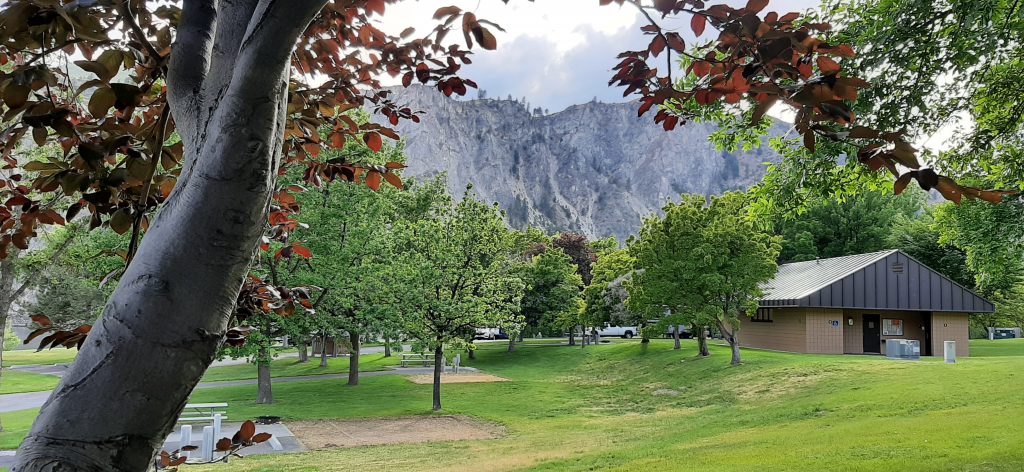
The vertical face of Earthquake Point from our campsite.
Pictures of this amazing place from other areas.
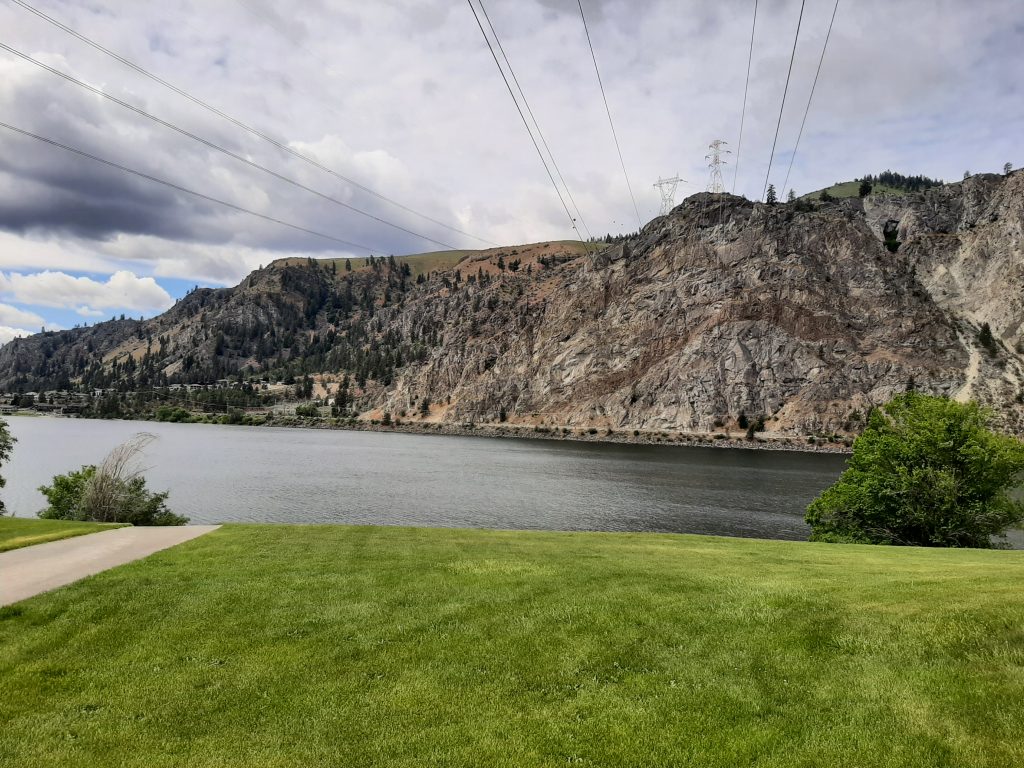
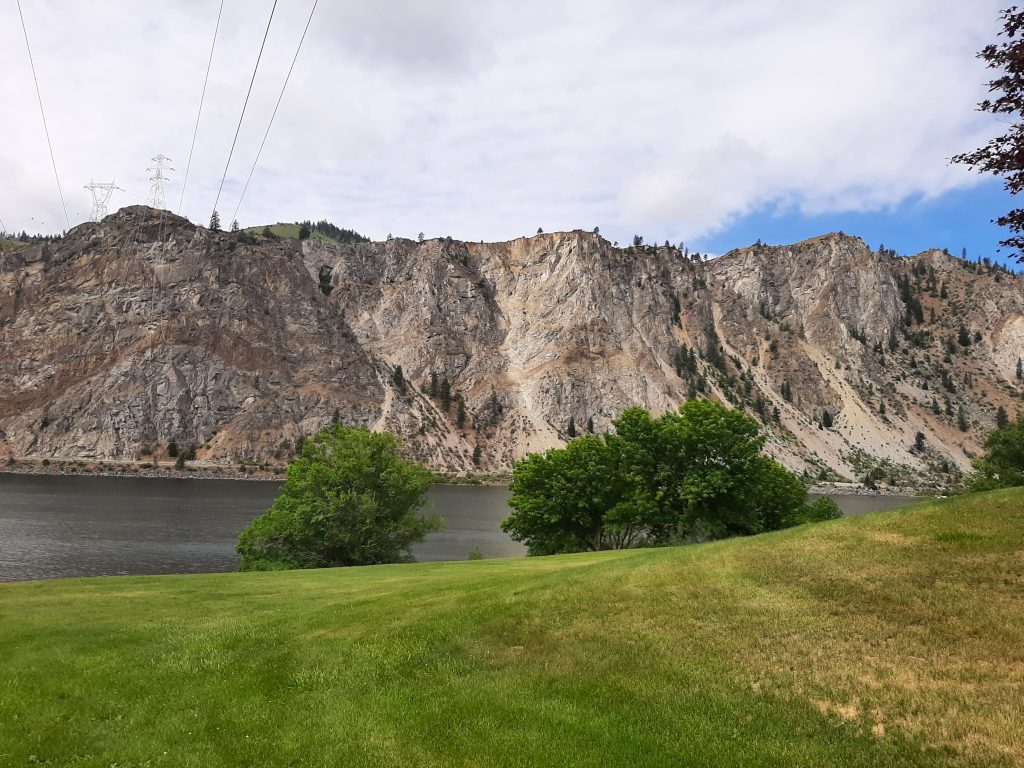
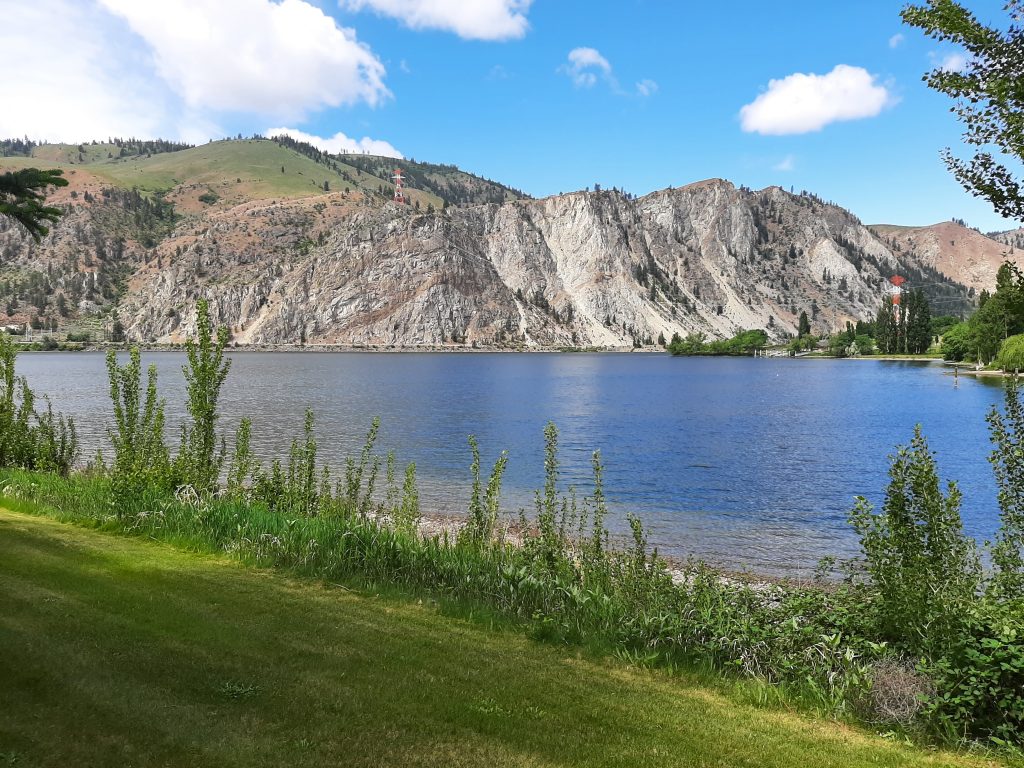
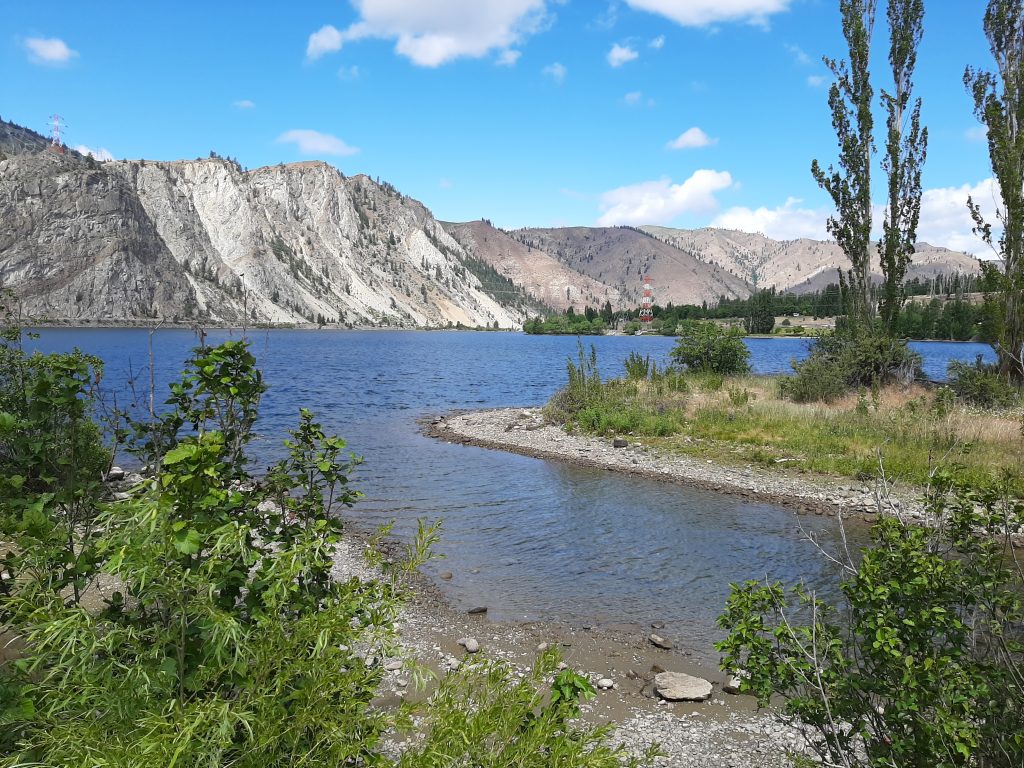
According to roadsideamerica.com “Earthquake Point and Ribbon Cliffs are natural formations left by a huge earthquake. The debris from the resulting rockslide actually stopped the flow of the Columbia River in December of 1872. The Indians in the area were told six months before the earthquake to move to a reservation upriver. This earthquake was taken as a sign, since the riverbed dried up as a result of the temporary dam built by the slide of debris. There are also black “ribbons” visible in the cliffs that were long-buried lava, now exposed. That’s how they got the name, Ribbon Cliffs.”
Needless to say, the cliffs are very dramatic. Spectacular would also define this small area of exposed rock and lava perfectly. So, once again, the state of Washington has provided us with another terrific place to park our trailer.
All in all, another wonderful day of seeing new places and discovering some of the natural wonders that make our state such a fantastic place to live.
MAY 28, 2024 – DAROGA STATE PARK
Woke to semi-sunny weather but lots of wind and a small chance of rain. So, what to do today? Go golfing of course! So, Andy made a tee time for 11:49 am at a golf course in Chelan.
Now this was not just a golf course. This was a posh golf course. Up on the side of a mountain with fantastic views of Lake Chelan. And no, I don’t golf. I went along as the golf cart designated driver and staff photographer. And yes, I love to drive golf carts and watch as Andy spends time hitting a very small ball into a very small hole. While trying very hard to stay on the fairway and not hit any trees or lose any balls in either a marsh, lake, rattlesnake or bear (first hint) den, ruff, or the yard of one of the homes situated sometimes quite close to the fairway or green. But with a bit of luck, and a goodly amount of skill, he didn’t lose a ball or even end up battling his ball out of one of the plentiful deep sided sand traps. (To tell the truth, I was very impressed.)
Now, in case you were wondering what course we visited, I will give you the name later in my narrative. (Hints will be given along the way.) Because for those of you who have golfed in the area, you might find it fun to guess the name of the course as I describe the fun time we had.
When we first arrived, we were met by a nice older gentleman in a golf cart that would turn out to be our ride for 16 holes. He thought it was grand that I was along to act as this fine gentleman’s chauffeur. Then he explained some of the intricacies of a few of the holes to Andy and introduced me to the idiosyncrasies of the lithium battery powered contraption that would carry us up and down this very hilly mountain (second hint) golf course. But first to the clubhouse to pay for today’s adventure. Next bathroom stops for both of us before heading for the first tee.
Now I am not an expert golf cart driver, but I’m not a novice either. But this was the most fun I’ve ever had driving Mr. Carr from hole to hole. The majestic vistas along the way were enough to keep me thoroughly entertained. Along with Andy’s commentary about each hole. And to make driving more interesting, use of the large brake pedal was required between many of the holes. Also, the “give it gas” pedal was also put into play a lot since many of the fairways were uphill battles. And then there was the wind. And I do mean WIND. Not a nice gentle breeze, but a force that sometimes rocked the golf cart. By the 14th hole, I was forced to add a 4th layer to stave off frost bite. Not really. It wasn’t that cold. But it sure wasn’t warm either.
Some pictures along the way
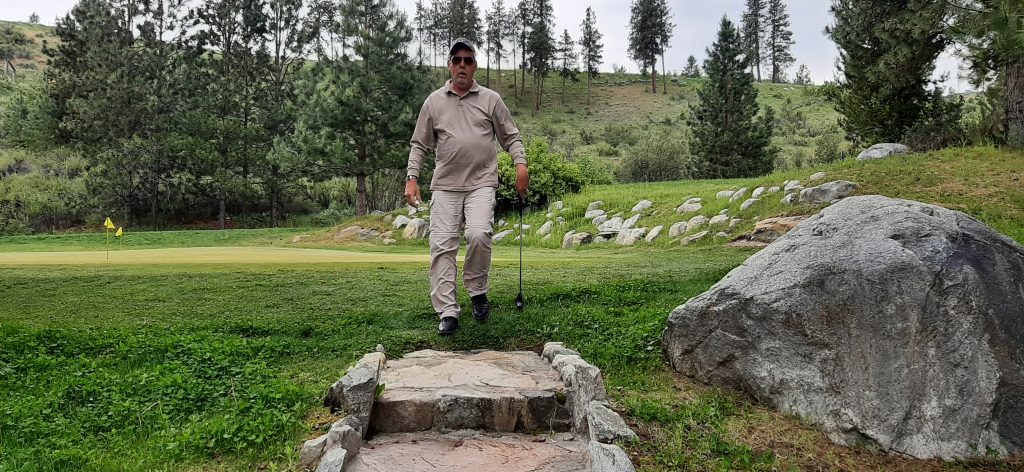
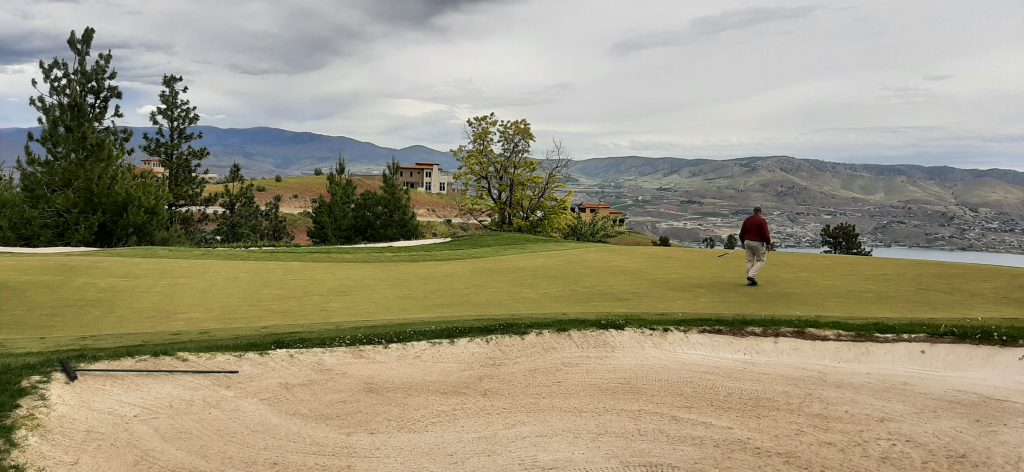
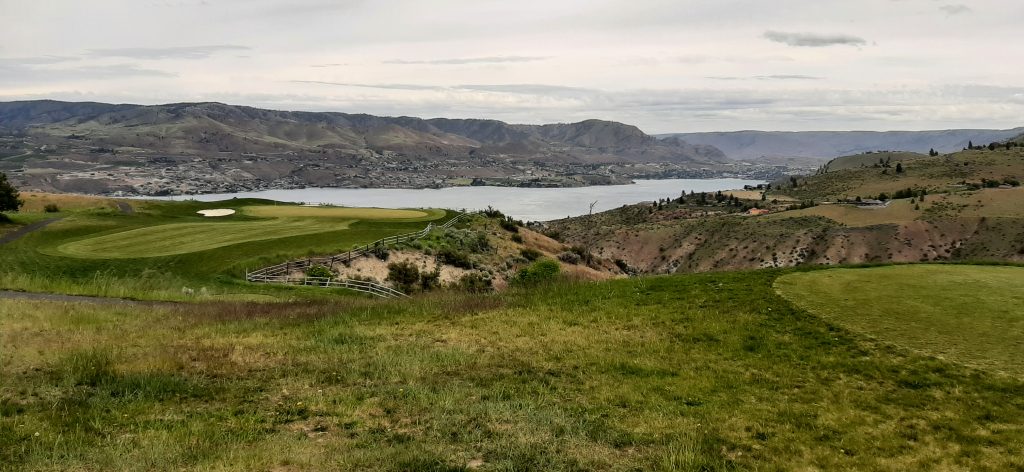
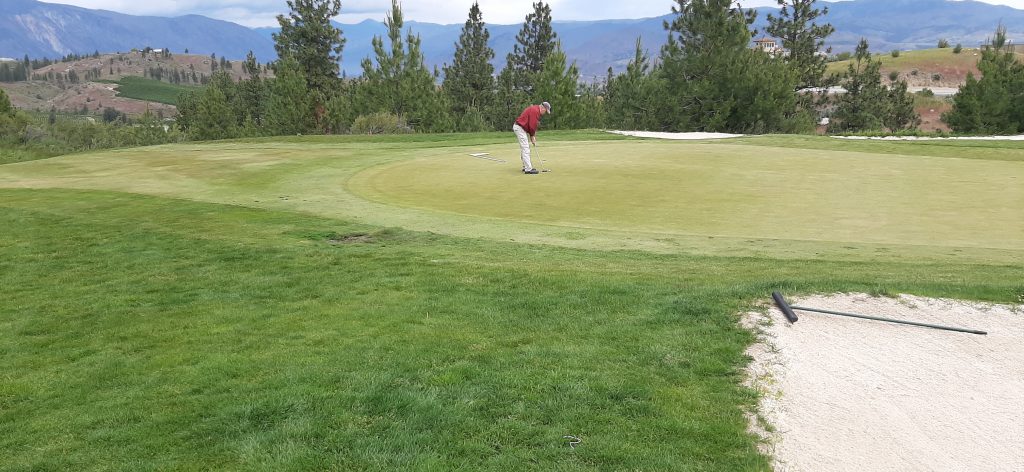
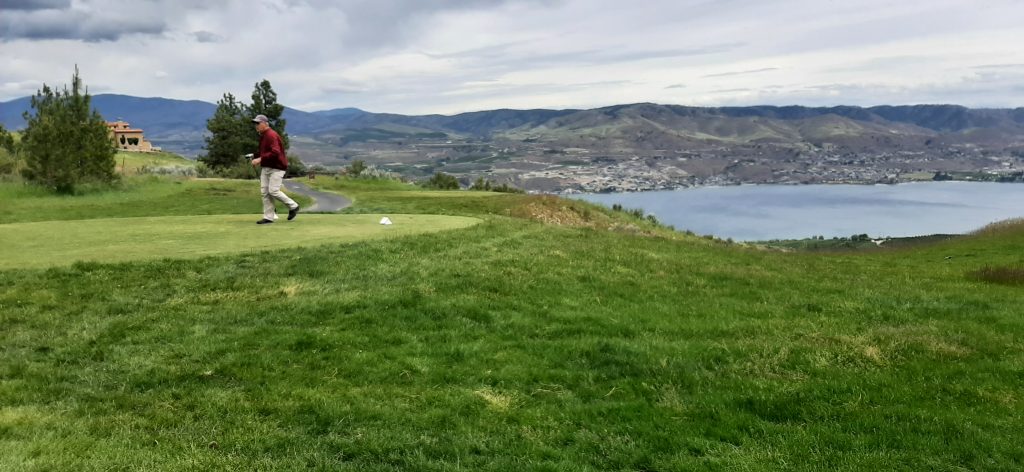
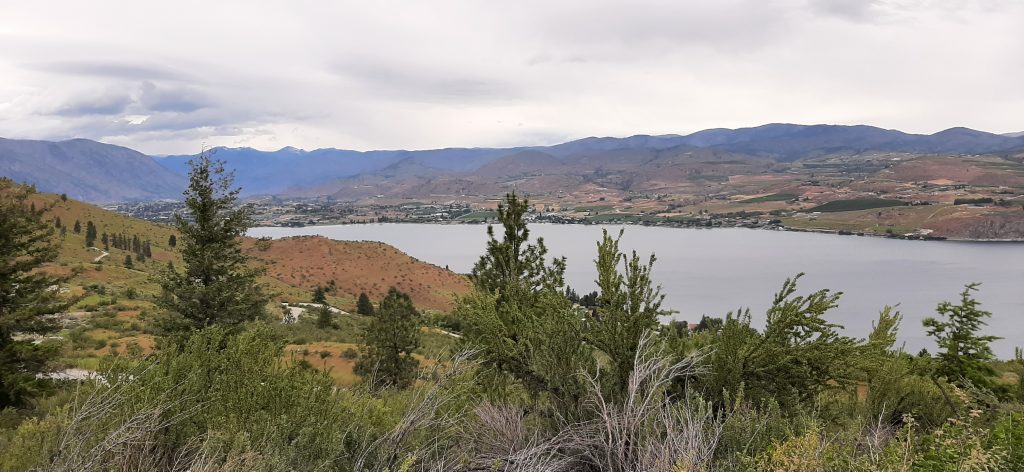
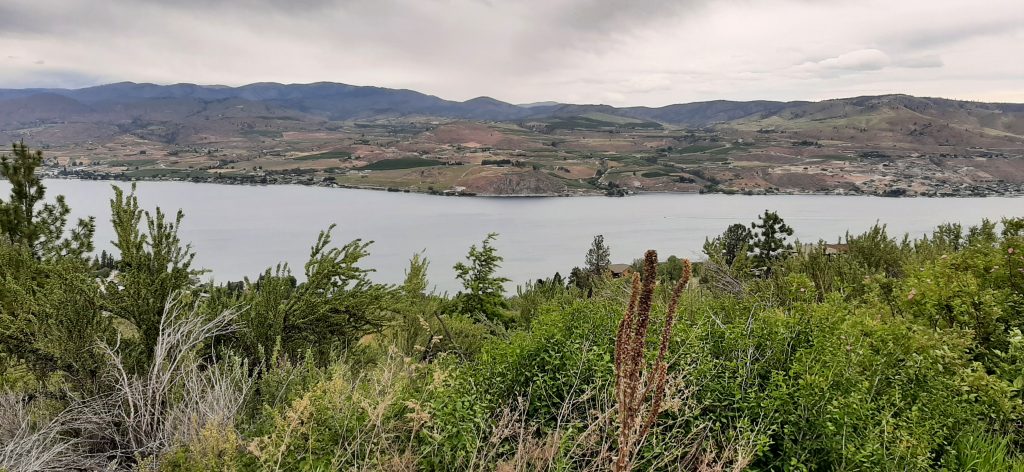
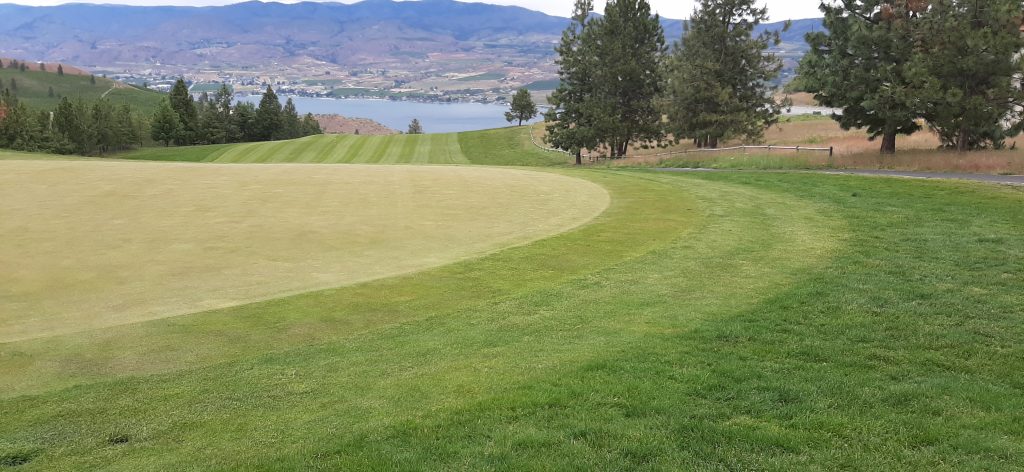
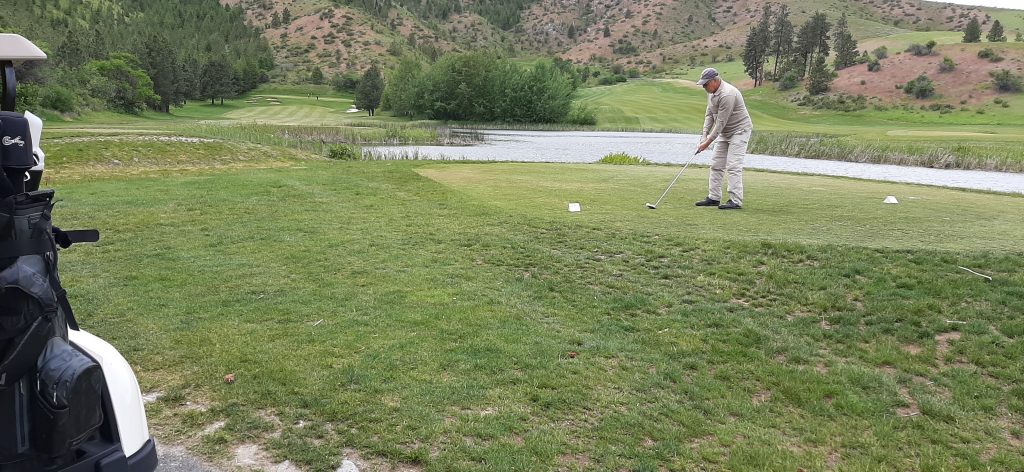
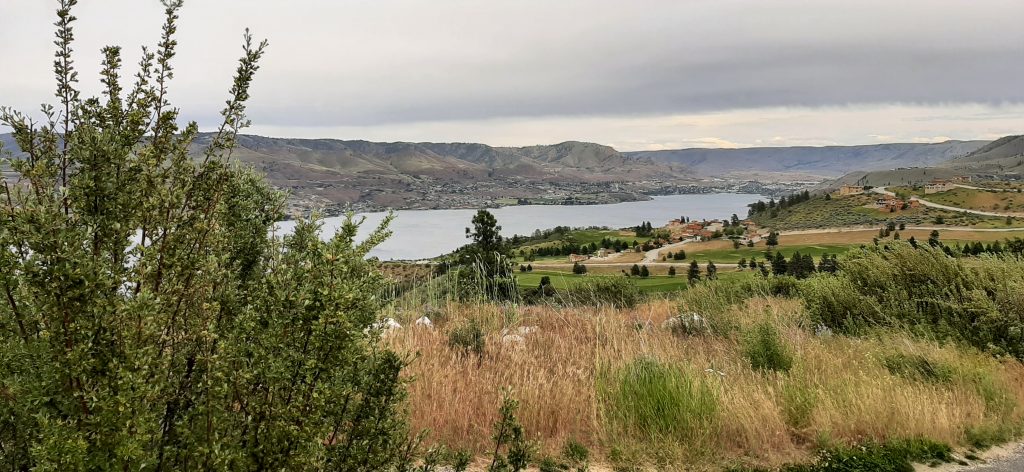
Well, I suppose I should provide you with the name of this golf course. Because if you are ever in the Chelan area and want to drive yourself crazy by hitting a tiny ball into the habitat of bears, deer, cougars, snakes, and every kind of ground varmint known to civilized man, then this is the place for you! It’s called Bear Mountain Ranch Golf Course.
And from their website “The Golf Course at Bear Mountain Ranch is a Championship level 18-hole public play course providing residents and visiting golfers with upscale services and amenities.
Opened in 2005, BMR was recently ranked as one of the top six new golf courses in the United States by PGA Professionals and in 2014 it was rated 10th best in Washington State. The golf course utilizes the rolling terrain and natural plateaus, providing golfers with panoramic views and a spectacular golf experience. In addition to the lush fairways and bent grass greens, it is not unusual to spot a deer and other wildlife on any of the holes.
Open from April to the end of October, the immaculately maintained, 350-acre course with an elevation gain of 700 feet, compares with many of the finest resort courses in the country.
The course easily accommodates golfers of all experience levels, from beginner to expert, by offering five sets of tees per hole.”
By the time we got back to camp it was 4:10 pm. And we were hungry since our lunch had consisted of a granola bar each. So, after Mr. C. mixed me a drink, I got busy building big old hamburgers. With chips on the side.
After dinner we read for a while and then an early to bed for both of us.
Another wonderful day of fresh air, beautiful surroundings, and the joy of being in each other’s company. Who could ask for any more from life?
MAY 29, 2024 – DAROGA STATE PARK
A bit about Daroga State Park
Daroga State Park is a 90-acre camping park with 1.5 miles of Columbia River shoreline on the elevated edge of the desert “scablands.” The park features camping activities and water-sport access in a unique and beautiful outdoor environment. The name “Daroga” comes from the first letters in the first names of the three Auvil brothers, Dave, Robert and Grady, who started an orchard/ranch at this site in 1928. The brothers developed a new type of peach on the ranch, catalogued as “the Daroga Peach.” In 1981, Grady Auvil sold the property to the state of Washington.
Well, the sun was shining this morning when we awoke, but the wind was still blowing. I don’t think we’ve had a calm day since we arrived in eastern Washington. Not one. But it also hasn’t rained on any of our hitching or unhitching. Which is always desirable.
After breakfast Andy took a long walk around our campground while I wrote up yesterday’s golfing adventure. When he got back from his walk I was finished writing, so we decided to take a short loop drive back up into the hills immediately east of us.
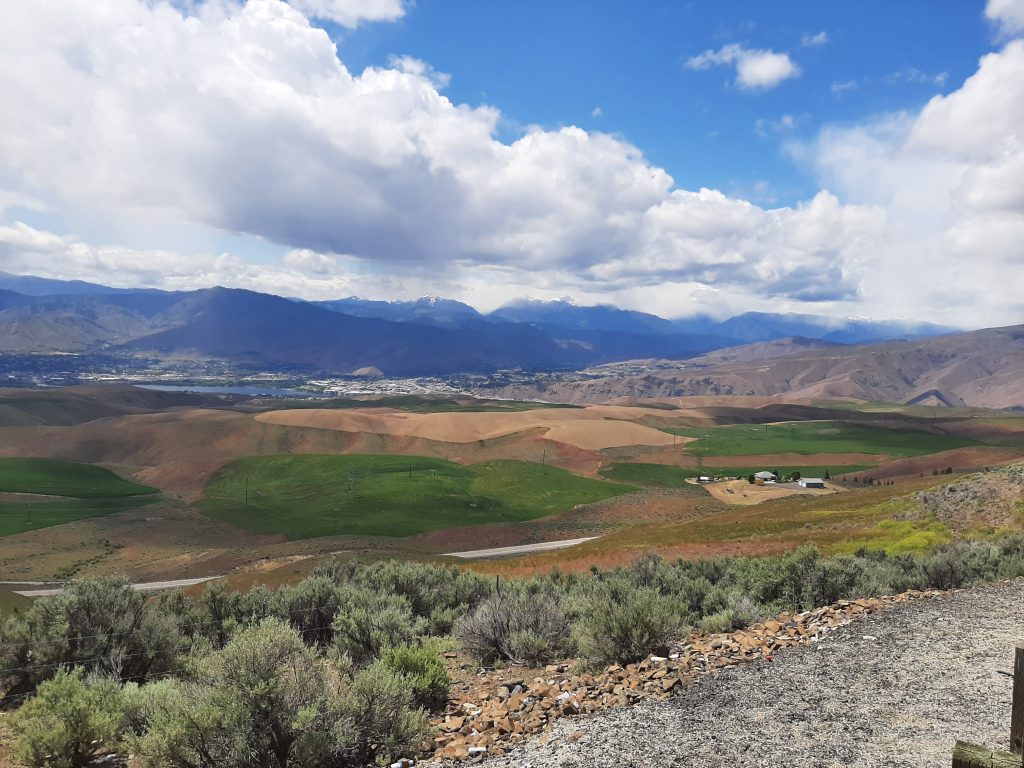
Looking down at Wenatchee from the east
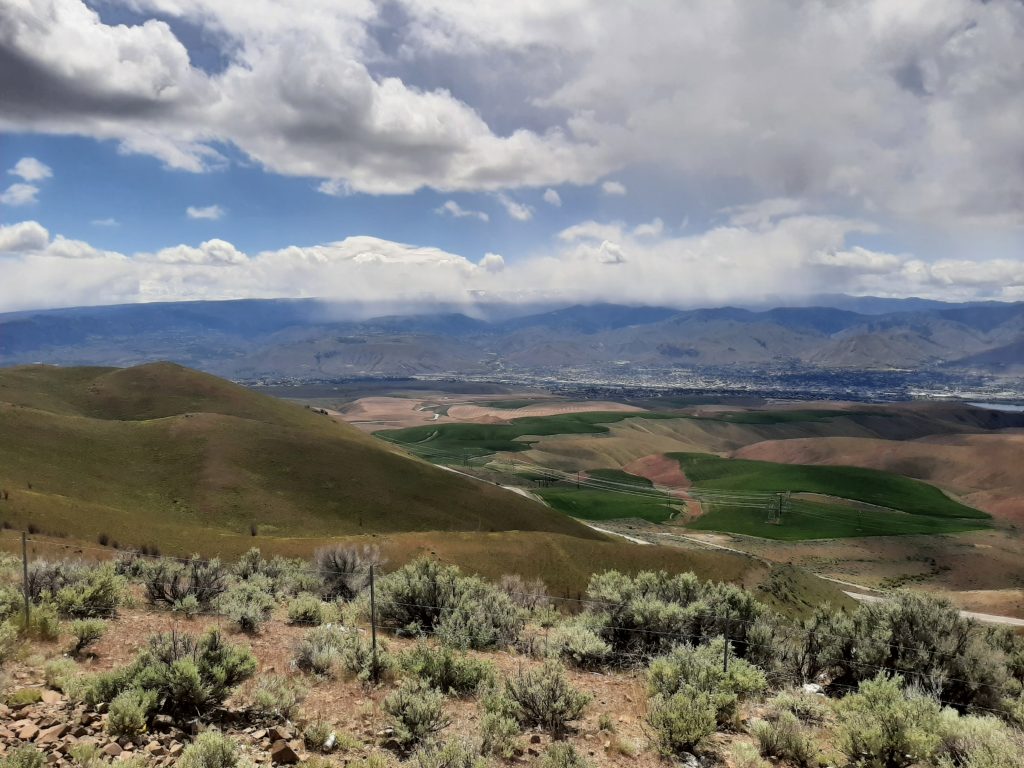
So, back to Orando and east on US-2 towards Waterville. Just before we reached the teeming metropolis of Waterville, we turned right onto P Road NW. At the T we turned right onto Badger Mountain Road past the Badger Mountain ski area (lame) and up into the hills. And what a nice ride this was. Then down, down, down to East Wenatchee. But all along the way down this long hill we could see everything from Mission Ridge to the mountains behind Leavenworth and even further north. We could also see all of Wenatchee sprawled before us. Actually, an incredible vista.
On the way back to camp we turned into Lincoln Rock State Park to give it a look see. We immediately decided that this was a state park that we very much needed to stay at in the future. Even the wildlife (marmots) came out to greet us as we were driving around this very popular campground.
Then back to camp for some lunch and reading our books outside in the sun. After a bit I decided even if the sun was shining, it was still too bloody cold to sit outside. The wind was still periodically whipping through the area and trying it’s darndest to knock over my comfy camp chair even thought I was still in the chair! The nerve of it! I finally decided the wind had won and came inside.
But I could still see Mr. C. and the mighty Columbia through the trailer’s back window when occasionally I lifted my eyes from the words of Michael Dibdin. A nice way to spend our last full day in camp.
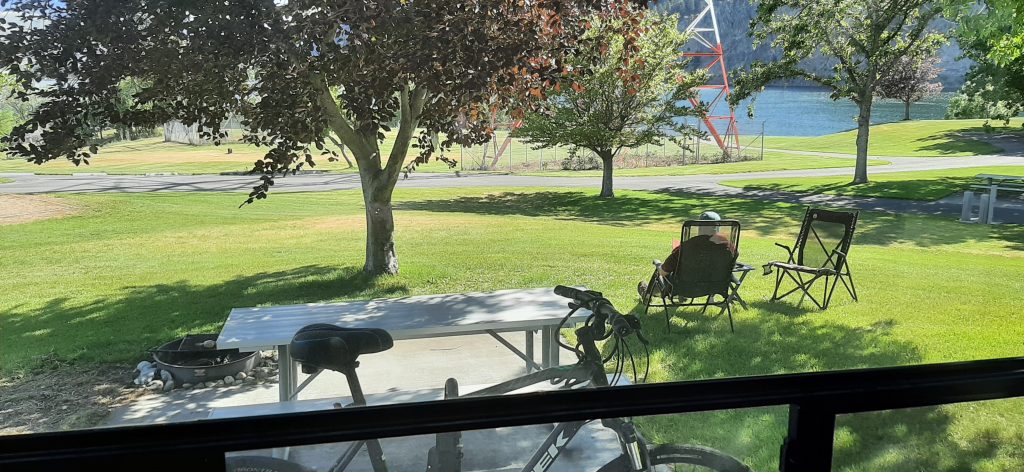
When both of us became hungry, we drove into Wenatchee for dinner at Red Robin. I didn’t feel like cooking, and we didn’t have any local knowledge about where to eat. So, we chose a restaurant where we knew we could find something on the menu we liked.
Then back to camp for our last night in the trailer. And my last night for a while without my other bed buddy Max, the cling on kitty.
But I’m ready to go home. And best of all, we were headed back to our favorite camping place – Chez Carr. There truly is no place like home.
MAY 30, 2024 – CHEZ CARR, CAMANO ISLAND – site 1082 Lightning Way
Being the intrepid travelers that we are, we decided to take the North Cascades Highway home. Great choice.
There is just something about the grandeur of this part of our state that almost brings me to tears. How can anything be this beautiful? And how can any person living in this part of the world not want to make sure this beauty is still around for future generations?
Some pictures I snapped along the North Cascades Highway
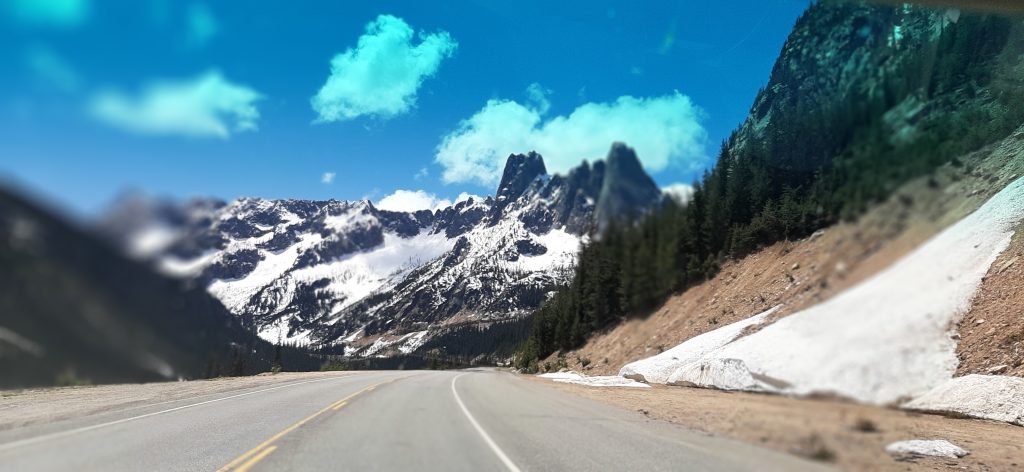
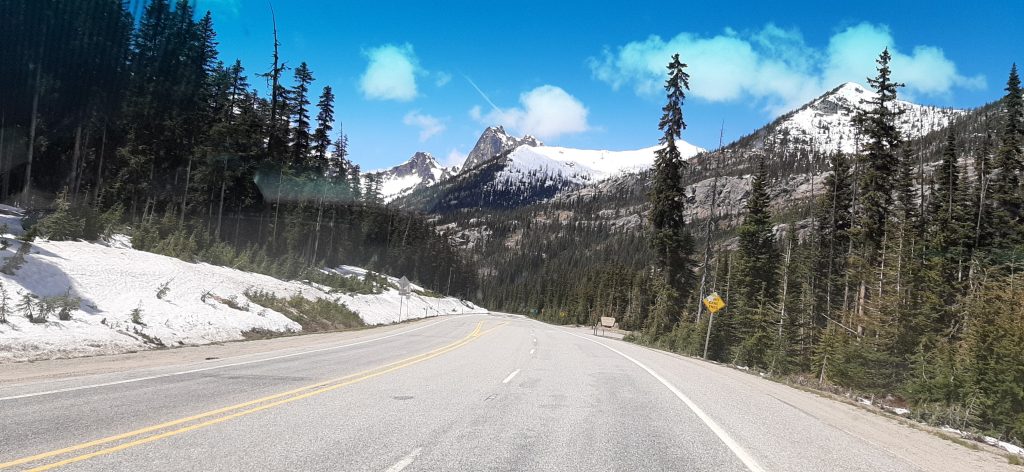
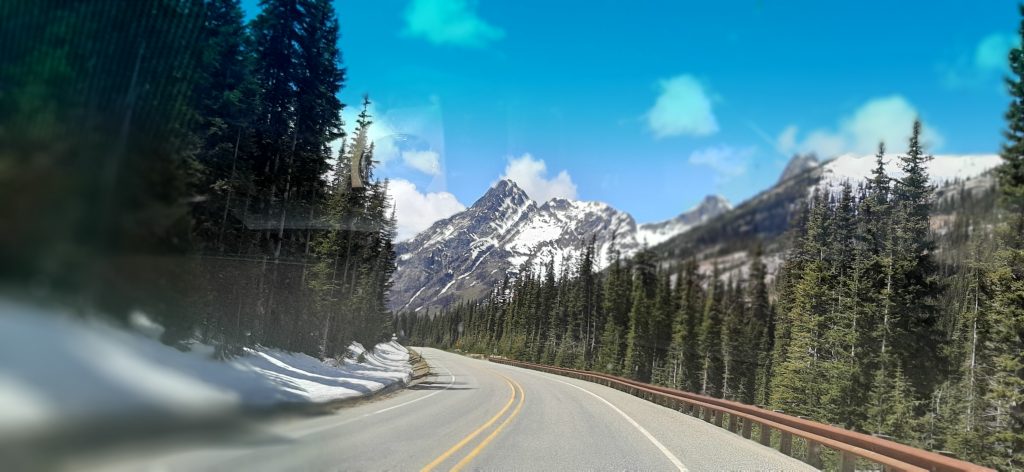
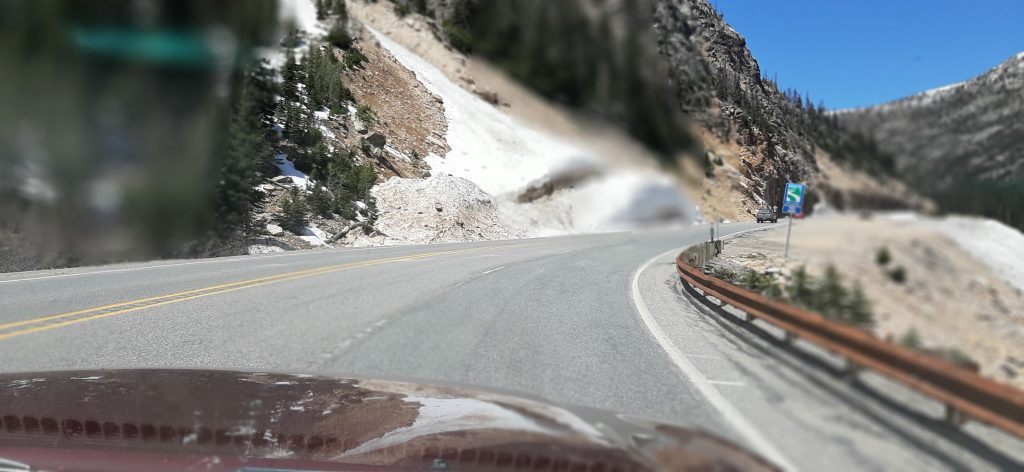
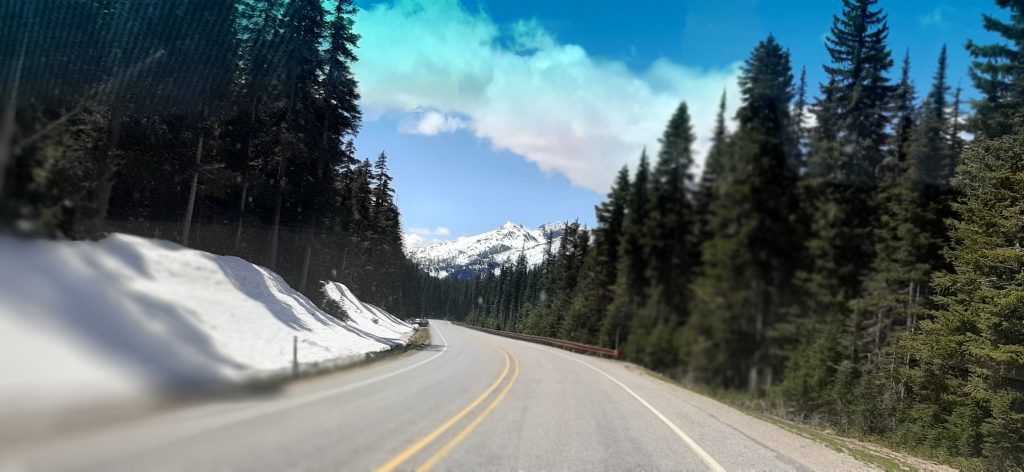
I’ve said it before, and I will continue to say it – I am lucky. Lucky to have a wonderful husband, family, and friends who care about the environment, care about the rights of others, don’t care what “color” anyone happens to come in, doesn’t give a flying fig about a person’s sexual persuasion, and respects a woman’s right to make choices about her own body. To name a few of the qualities that make for thoughtful and humanitarian individuals.
So, my wishes for you – the joy of travel, an abundance of good friends, fabulous food at every meal (this is a cooking blog after all), the ability to laugh when really all you want to do is cry, and the independence and enjoyment that comes from just being comfortable in your own skin.
And of course, as always, peace, love and happy trails to all.
